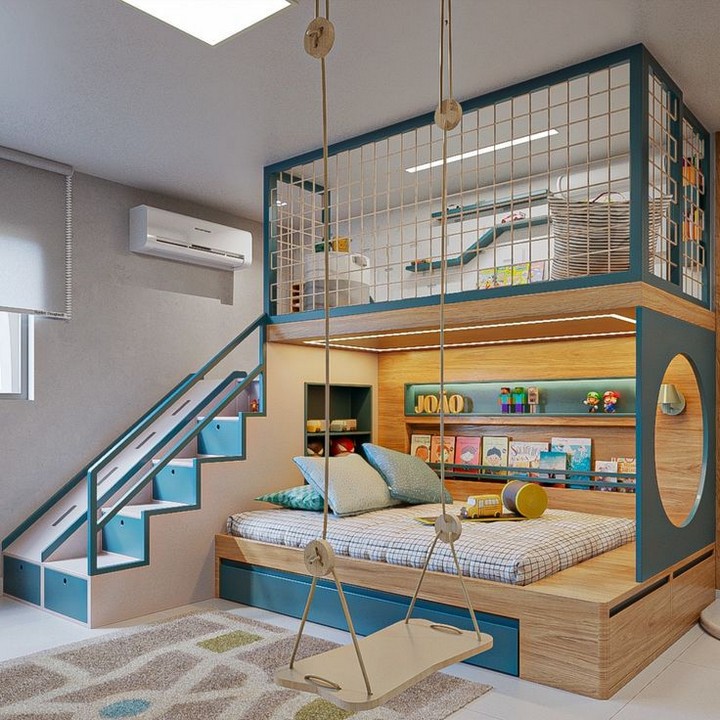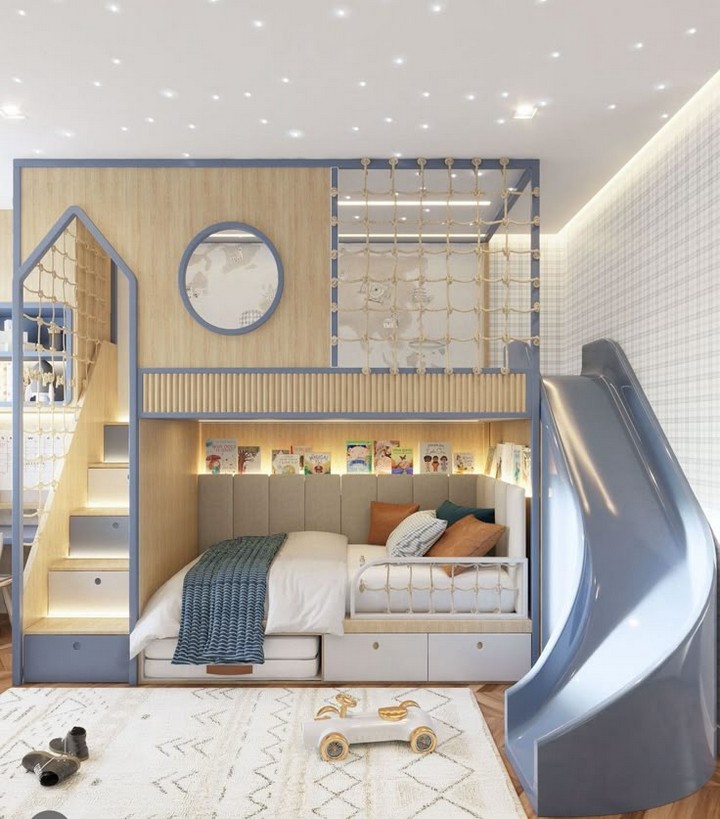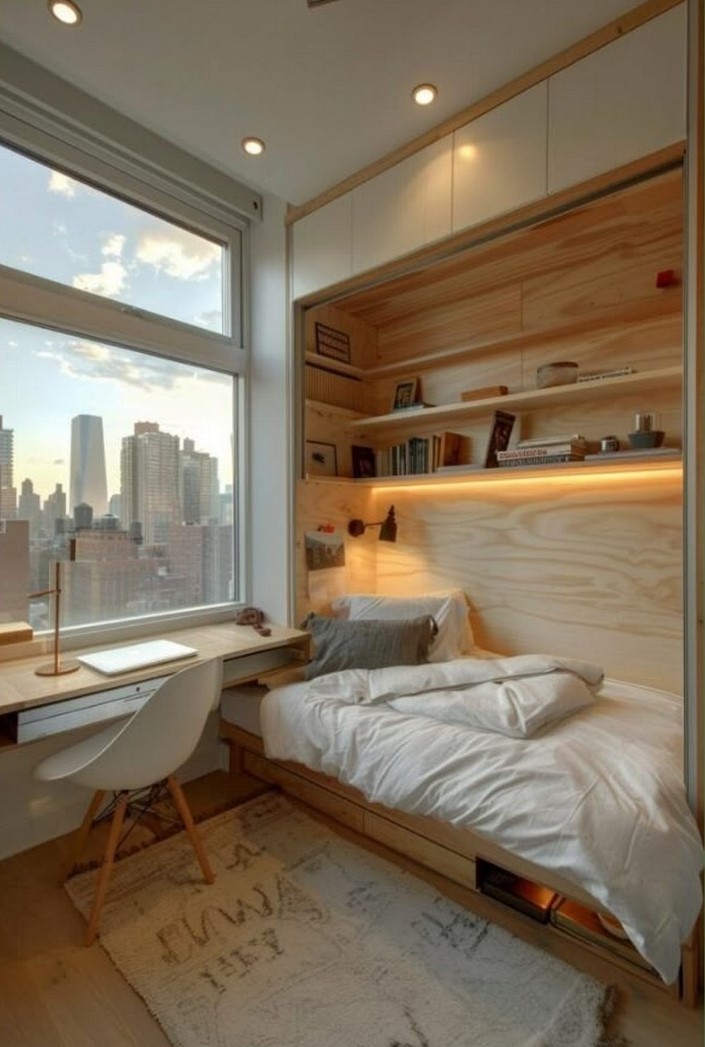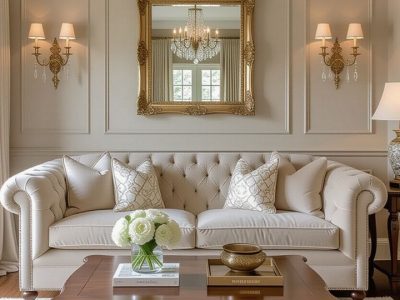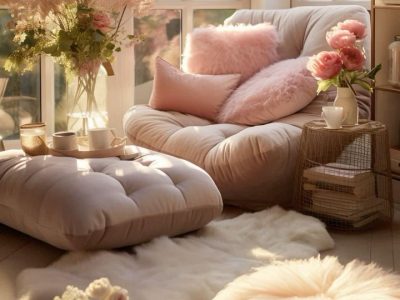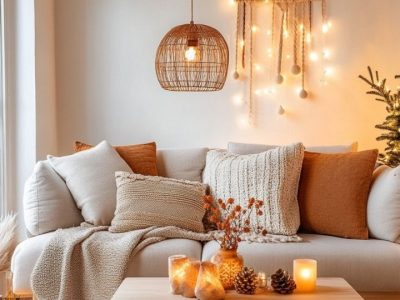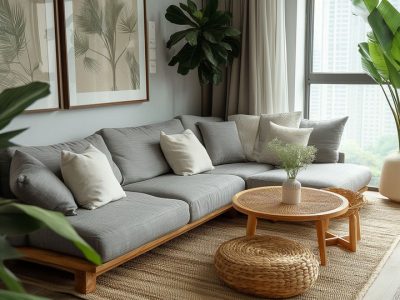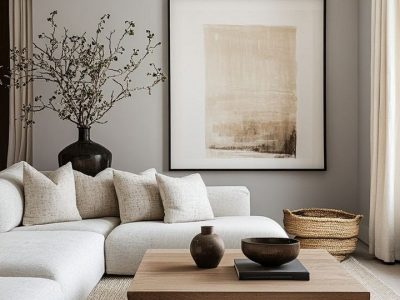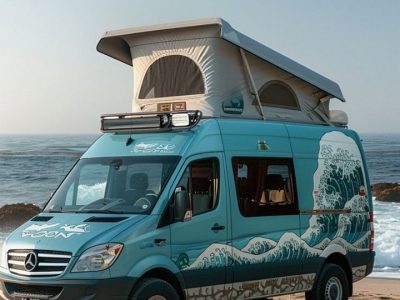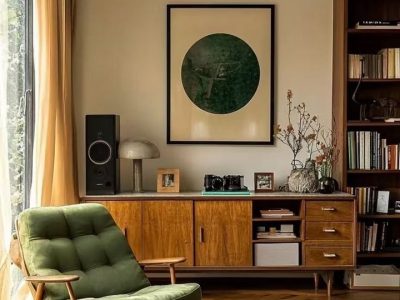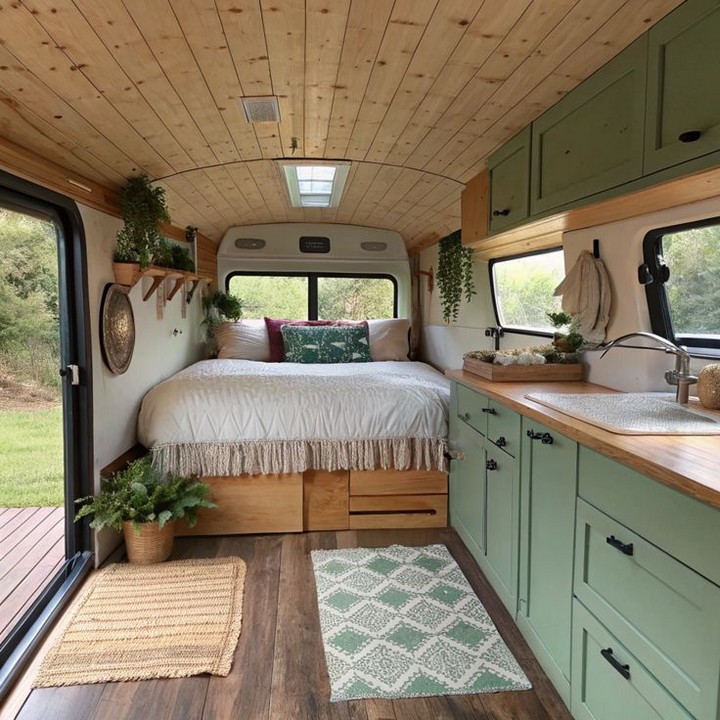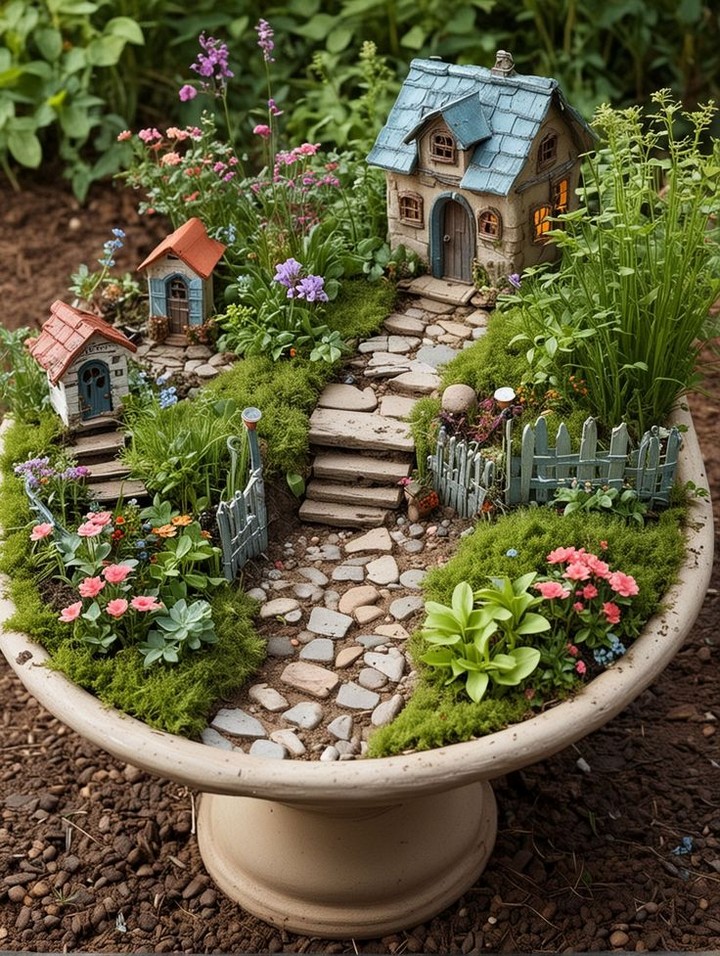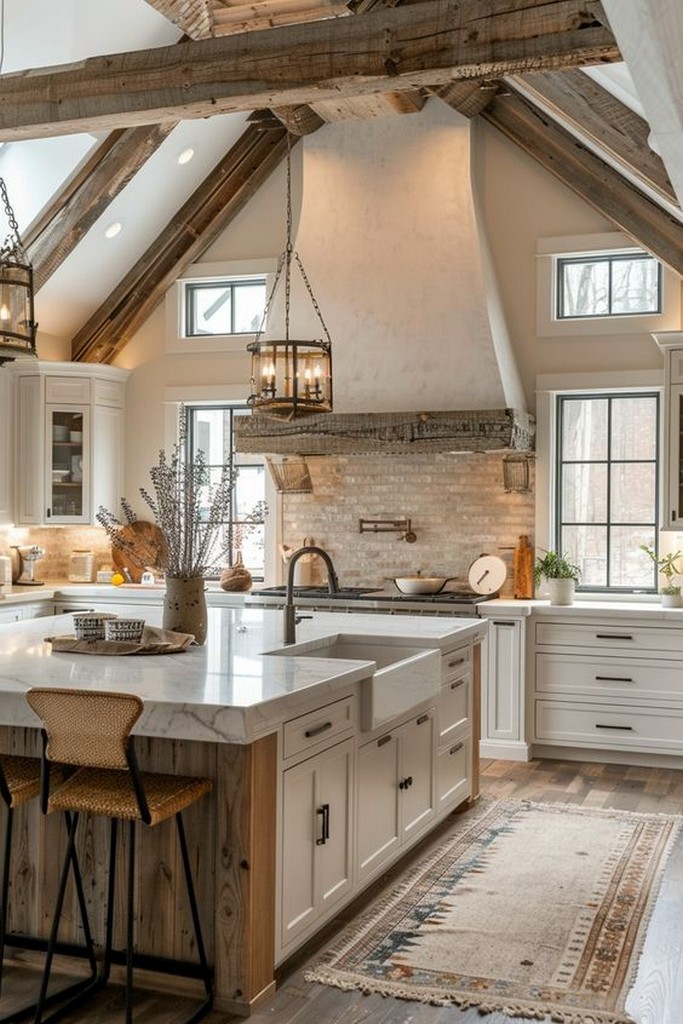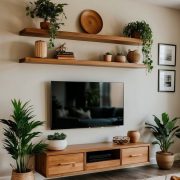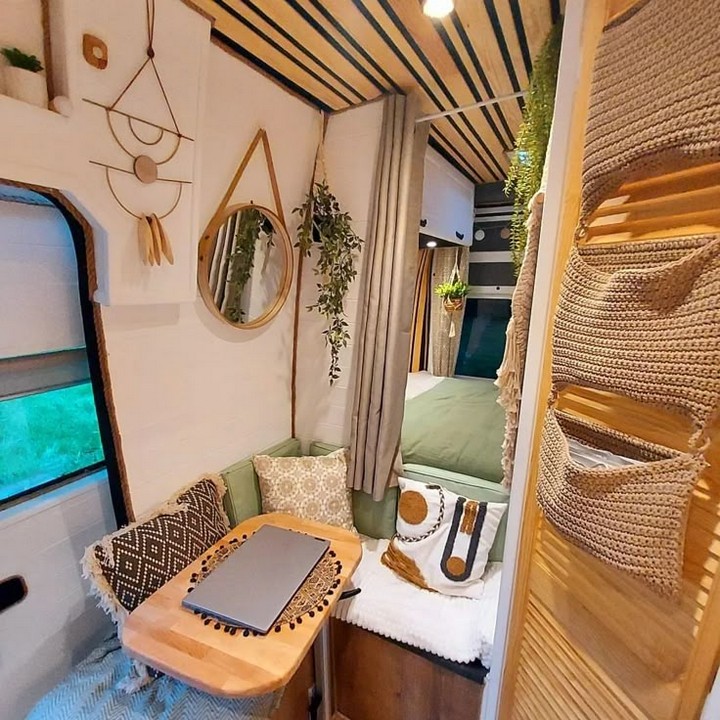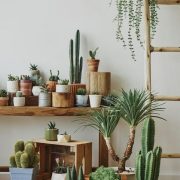In the world of children’s bedroom design, few furniture pieces offer the perfect blend of functionality, space efficiency, and sheer excitement quite like bunk beds. Whether you’re working with limited square footage, accommodating multiple children in one room, or simply looking to create a sleep space that sparks imagination, bunk beds represent an ideal solution that has evolved dramatically from the simple stacked frames of yesteryear.
Today’s market offers a stunning array of designs that transform the concept of “kids bunk bedroom” from merely practical to absolutely magical. From themed adventure bunks to sophisticated teen-friendly configurations, modern bunk beds are revolutionizing how we think about children’s sleep spaces.
In this comprehensive guide, we’ll explore 44 innovative kids bunk bedroom ideas that combine style, safety, and smart space utilization. Whether you’re designing from scratch or looking to refresh an existing space, these creative approaches will help you craft the perfect sleep sanctuary for your children.
Understanding the Appeal of Bunk Beds
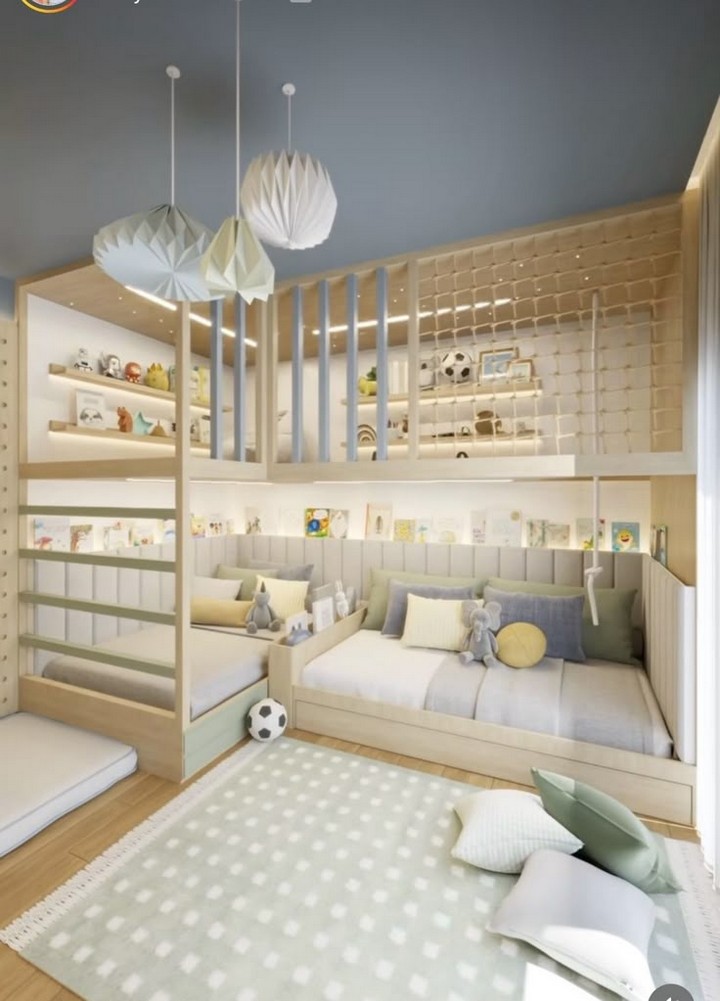
Before diving into specific design ideas, let’s explore why bunk beds continue to maintain their popularity in children’s bedroom design:
- Space Efficiency: The vertical design maximizes floor space, leaving more room for play, study, and storage.
- Sibling Bonding: Shared sleeping arrangements can strengthen relationships between siblings while still providing individual sleep spaces.
- Adaptability: Modern bunks can be reconfigured as children grow, separating into twin beds when needed.
- Fun Factor: Children naturally gravitate toward elevated sleeping platforms, finding them exciting and novel.
- Versatility: Today’s designs incorporate desks, storage, play areas, and other functional elements.
Safety Considerations for Kids Bunk Bedrooms
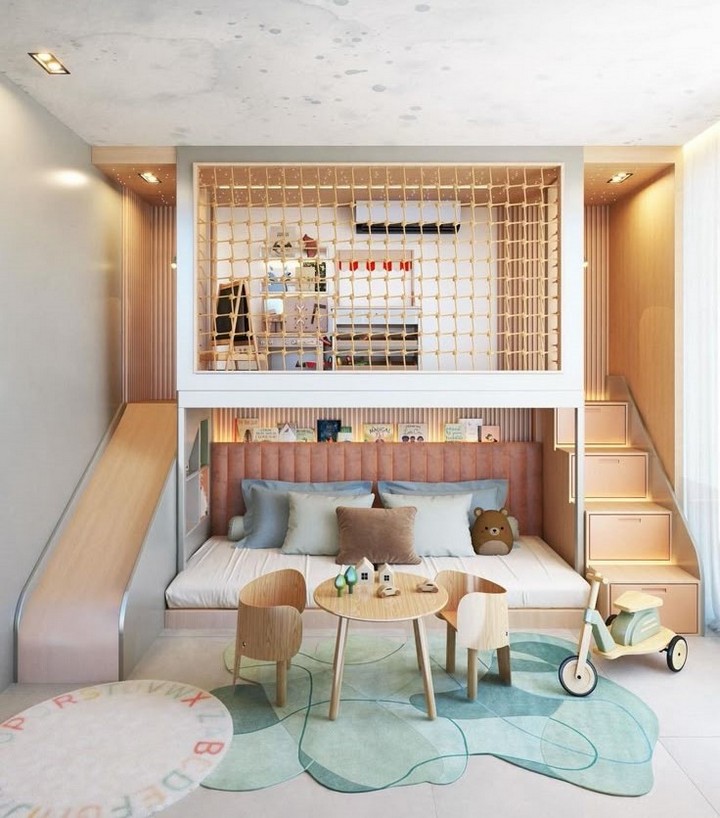
Safety should always be the primary consideration when installing bunk beds in children’s rooms. Here are essential guidelines to ensure a secure sleep environment:
- Age Appropriateness: Most safety organizations recommend that children under six should not use the top bunk.
- Guard Rails: Ensure top bunks have secure guardrails on all sides, with only one entry/exit point.
- Ladder Security: Confirm that ladders are firmly attached and have rounded edges.
- Ceiling Clearance: Maintain at least 30 inches between the top mattress and ceiling to prevent injuries.
- Quality Construction: Invest in sturdy, well-built frames that meet safety standards and can withstand active use.
- Regular Inspections: Check hardware, connections, and support systems regularly for loosening or wear.
- Proper Lighting: Install adequate lighting for both bunks, especially night lights for safe navigation.
- Clear Floor Space: Keep the area around bunk beds free of toys and obstacles to prevent tripping hazards.
Now, let’s explore our 44 creative kids bunk bedroom ideas, organized into helpful categories to inspire your design journey.
Classic Bunk Bed Configurations with Modern Twists
1. Traditional Twin-Over-Twin with Updated Materials
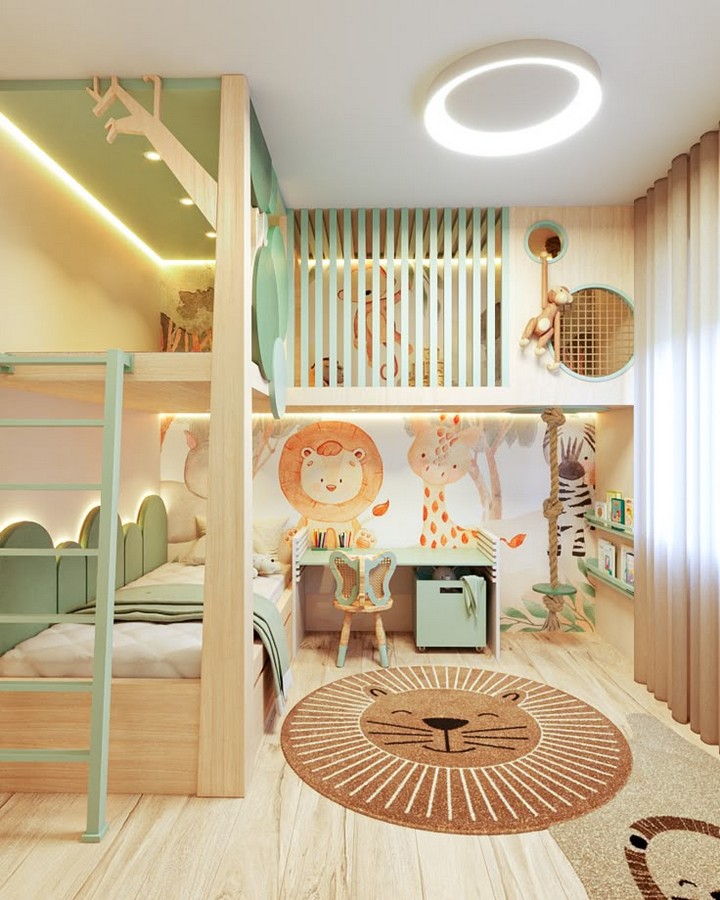
The conventional twin-over-twin configuration remains popular but can be refreshed with contemporary materials. Consider frames in sustainable bamboo, powder-coated metals in vibrant colors, or natural wood with non-toxic finishes. These updated material choices maintain the timeless design while adding modern appeal and safety features.
2. L-Shaped Corner Bunks
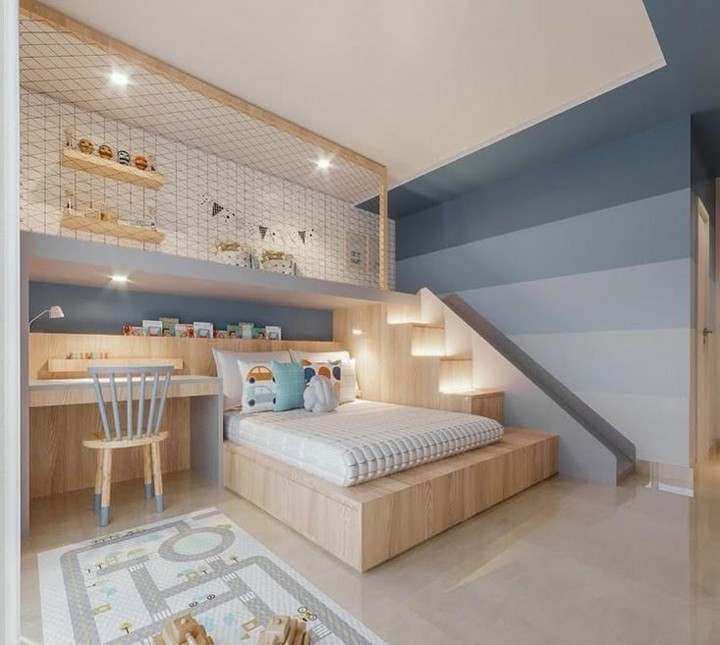
Maximize corner spaces with L-shaped configurations that place one bed perpendicular to the other. This arrangement creates a natural division in the room and opens up floor space in the center, perfect for shared bedrooms where children want defined personal zones.
3. Twin-Over-Full Combination
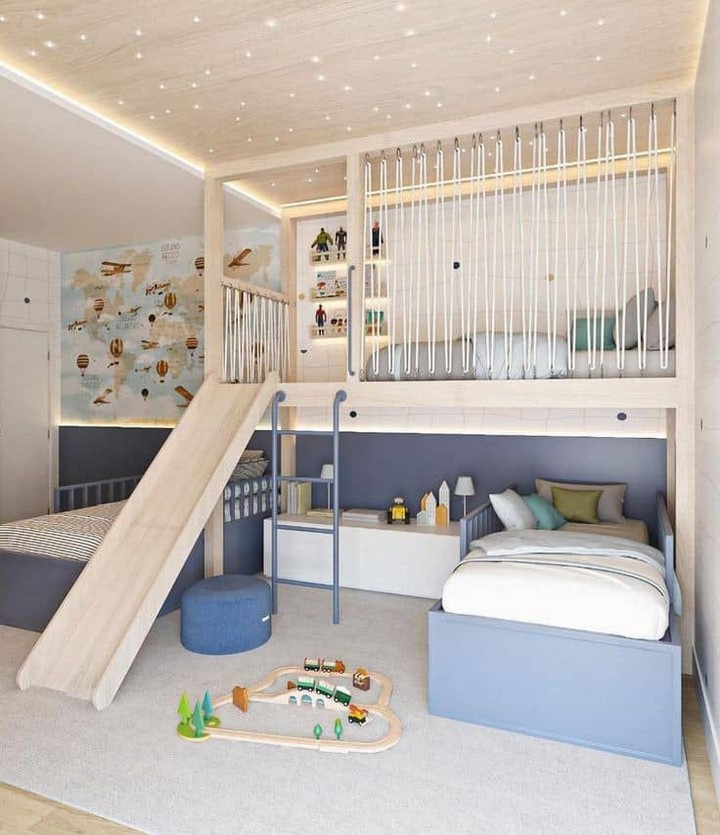
For siblings of different ages or sizes, the twin-over-full bunk offers proportional sleeping arrangements. The bottom bunk provides more space for an older child or can accommodate a parent for bedtime stories with younger children.
4. Triple Bunk Innovation
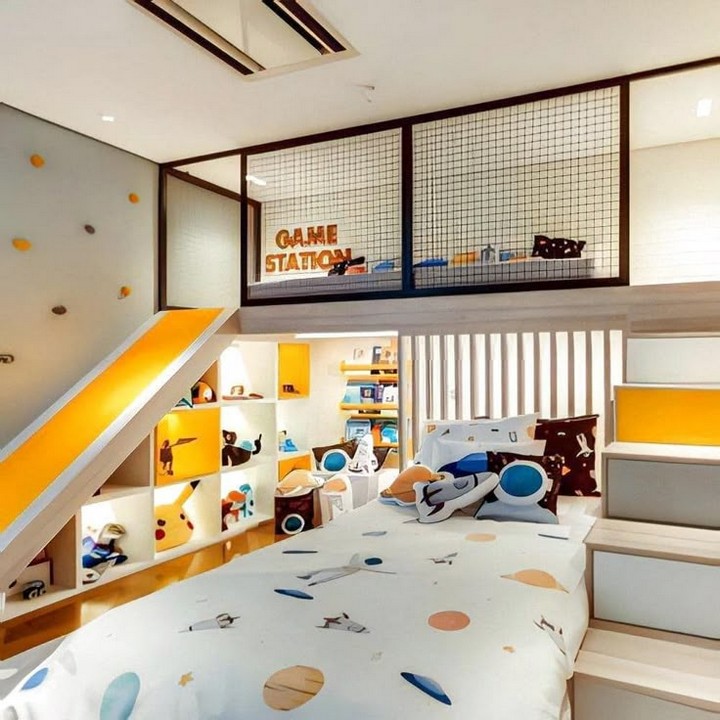
Families with three children sharing a room can explore triple bunk arrangements. These come in various configurations, including stacked verticals or L-shaped designs with two beds on the bottom and one elevated bed. Modern safety features make these practical options for larger families.
5. Quad Bunks for Maximum Capacity
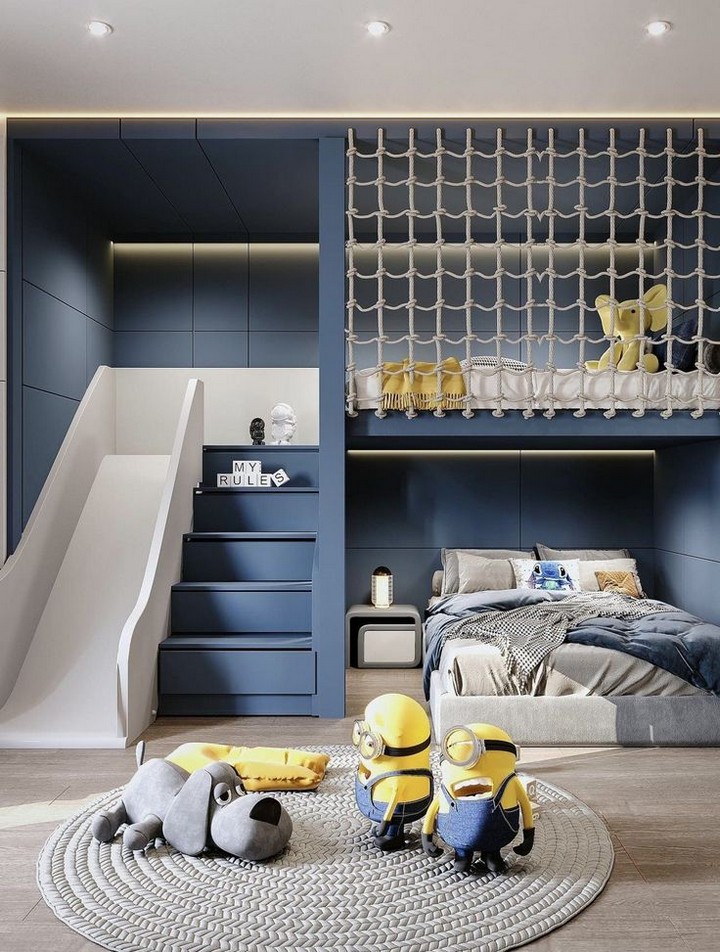
For larger families or vacation homes where multiple children need accommodation, quad bunk systems offer efficient solutions. These can be arranged as two sets of standard bunks or in corner configurations that maximize space while providing individual sleep zones.
Space-Saving Bunk Bed Solutions
6. Loft Beds with Desks Underneath
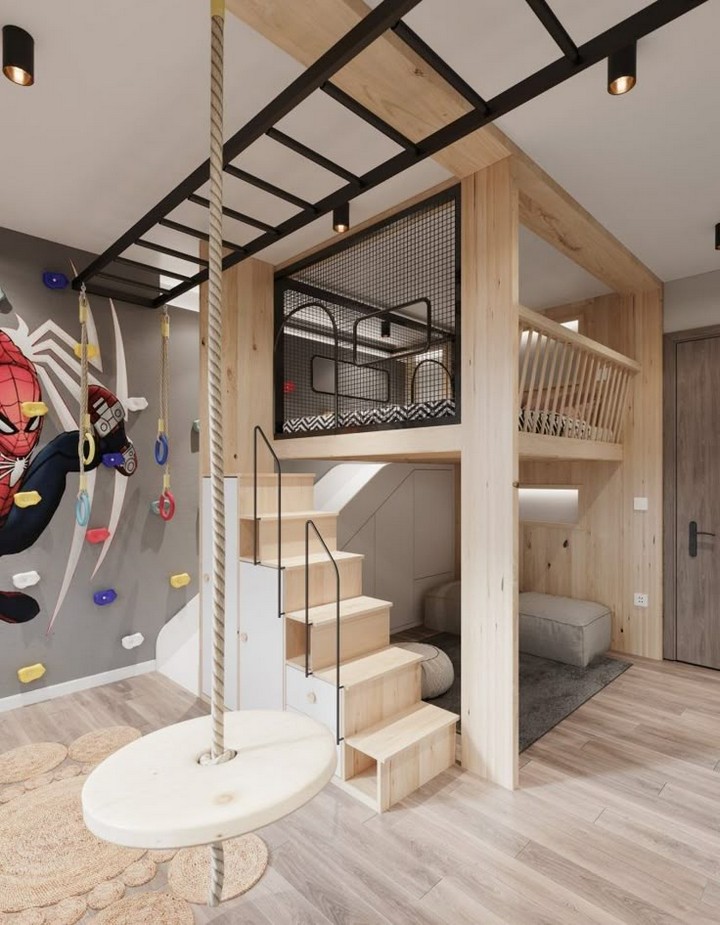
For school-aged children and teens, loft-style bunks with integrated study stations below make excellent use of vertical space. Look for designs with built-in shelving, task lighting, and cable management systems to create functional homework zones.
7. Compact Murphy Bunk Systems
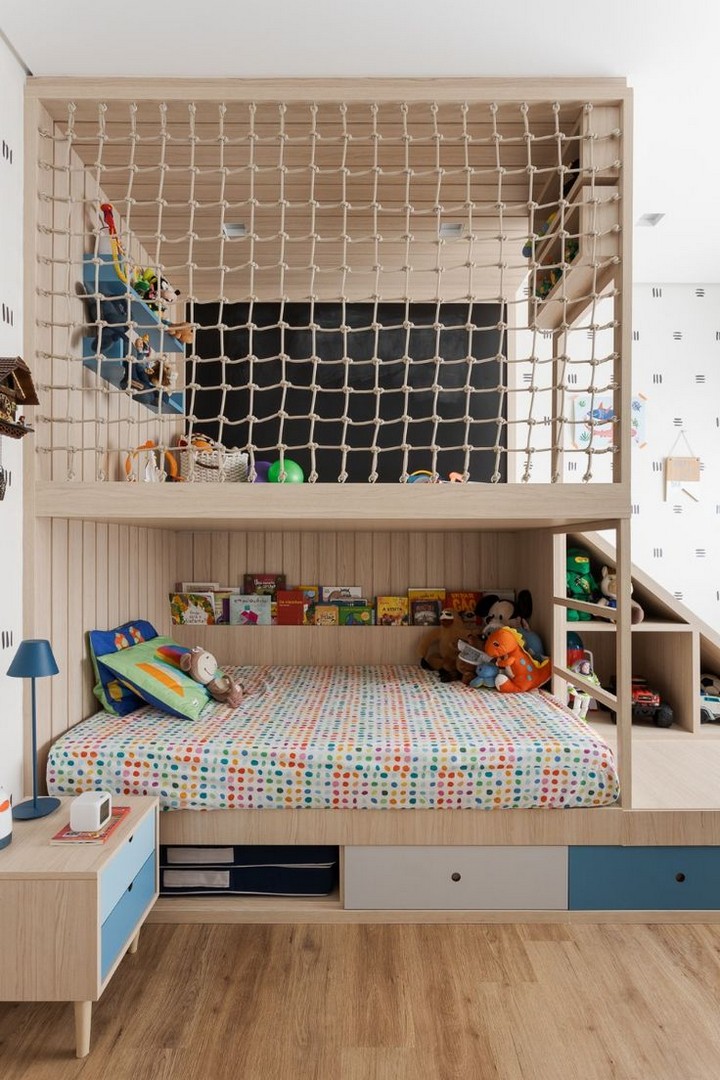
In truly tight spaces, murphy-style bunk beds that fold up against the wall when not in use represent the ultimate space-saving solution. These systems allow the bedroom to transform from sleep space to play area with minimal effort.
8. Low-Profile Bunks for Rooms with Height Restrictions
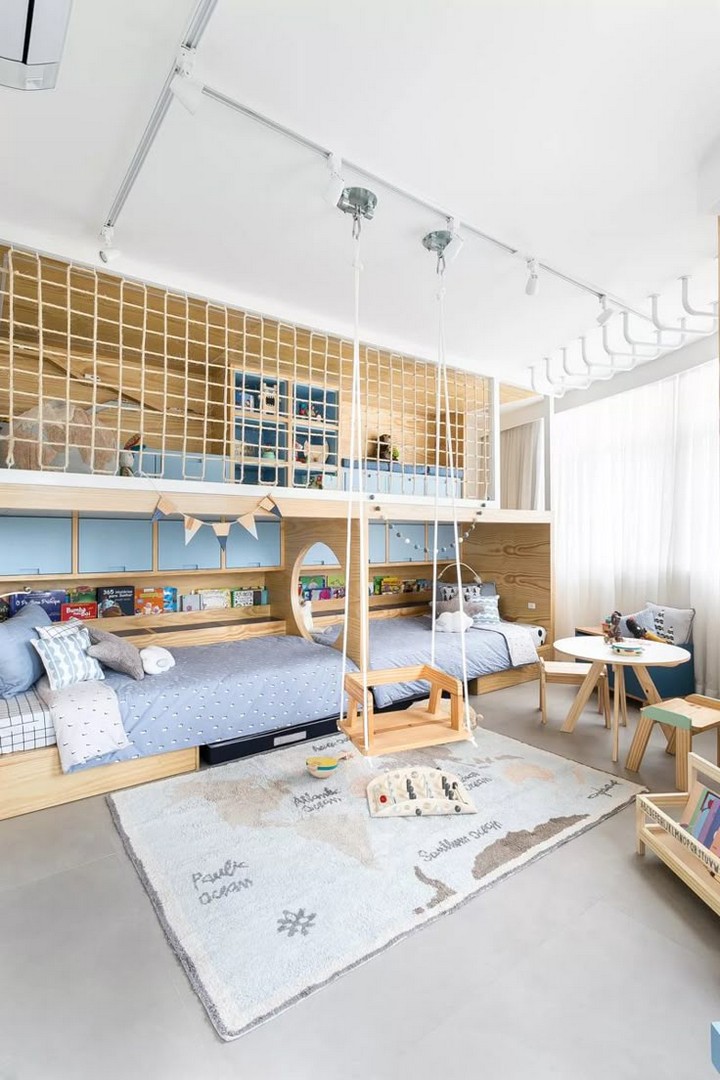
Rooms with lower ceilings can still accommodate bunk arrangements with specially designed low-profile frames. These maintain the fun of stacked sleeping while working within architectural limitations.
9. Trundle Bed Combinations
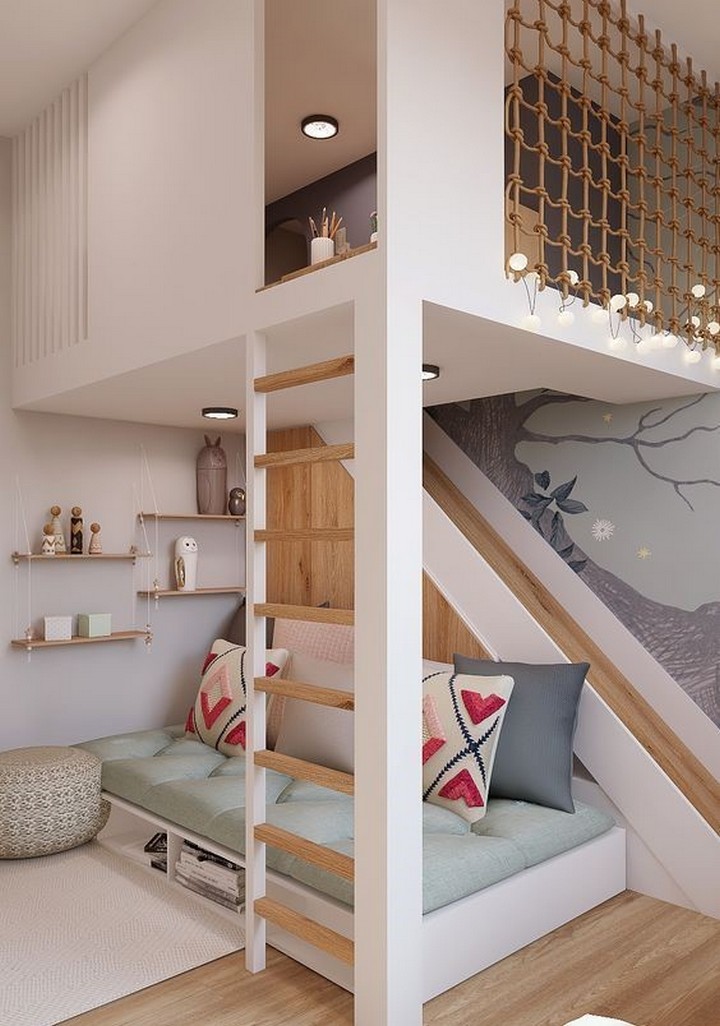
Bunk beds with integrated trundle units offer flexible sleeping arrangements for sleepovers or visiting family members. During the day, the trundle tucks away neatly, maintaining open floor space for activities.
10. Built-In Wall Bunks for Maximized Floor Space
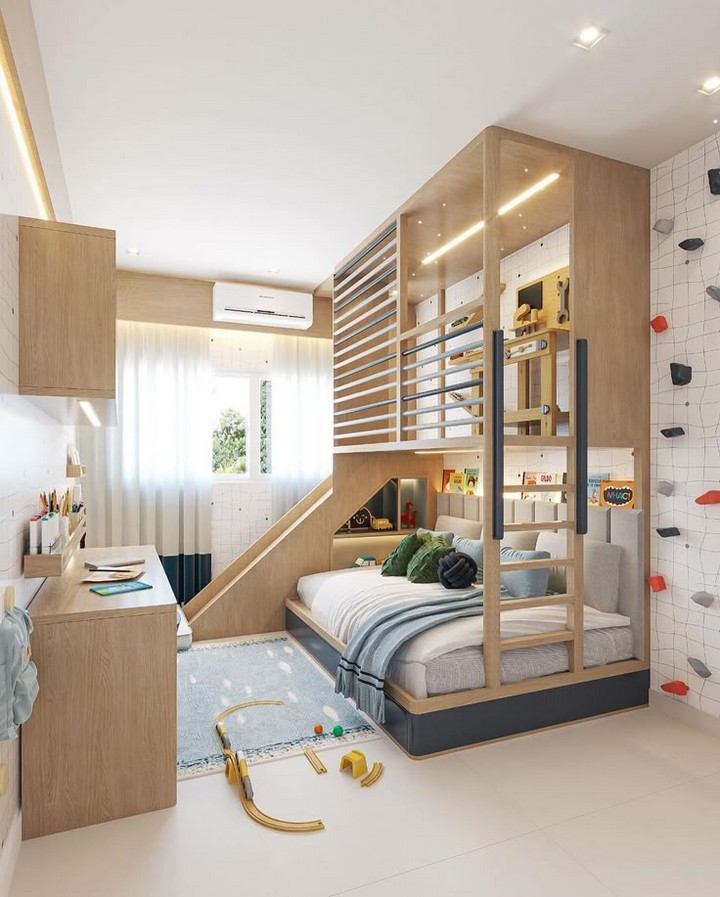
Custom-built bunks recessed into wall alcoves eliminate the footprint of traditional bed frames entirely. These architectural solutions can include integrated storage and display shelving within the same wall system.
Themed Bunk Bedroom Ideas That Spark Imagination
11. Treehouse-Inspired Adventure Bunks
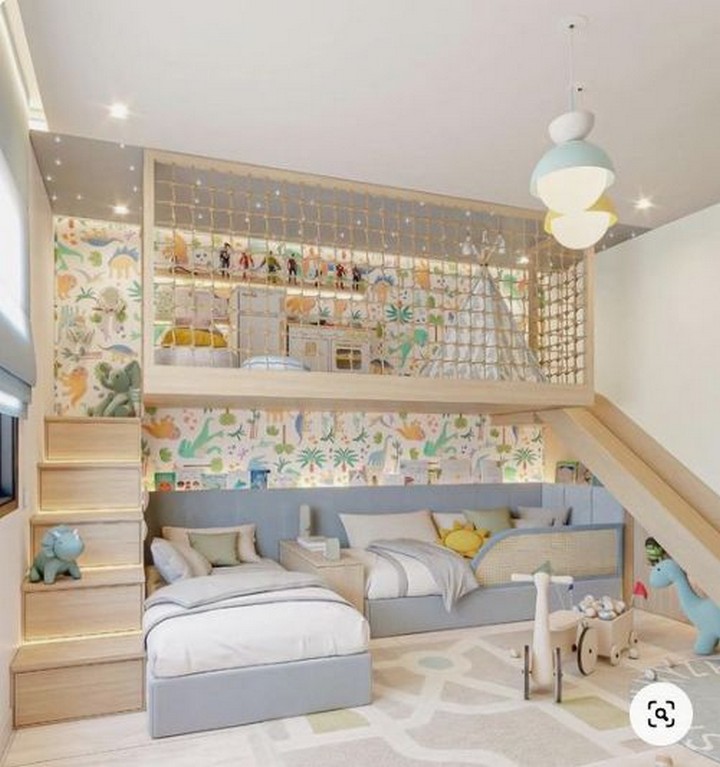
Transform ordinary bunks into treehouse retreats with design elements like branch-shaped supports, leaf-patterned bedding, and canopies that create the illusion of sleeping among treetops. Add rope ladders, climbing holds, or slide exits for enhanced playability.
12. Castle and Princess Tower Bunks
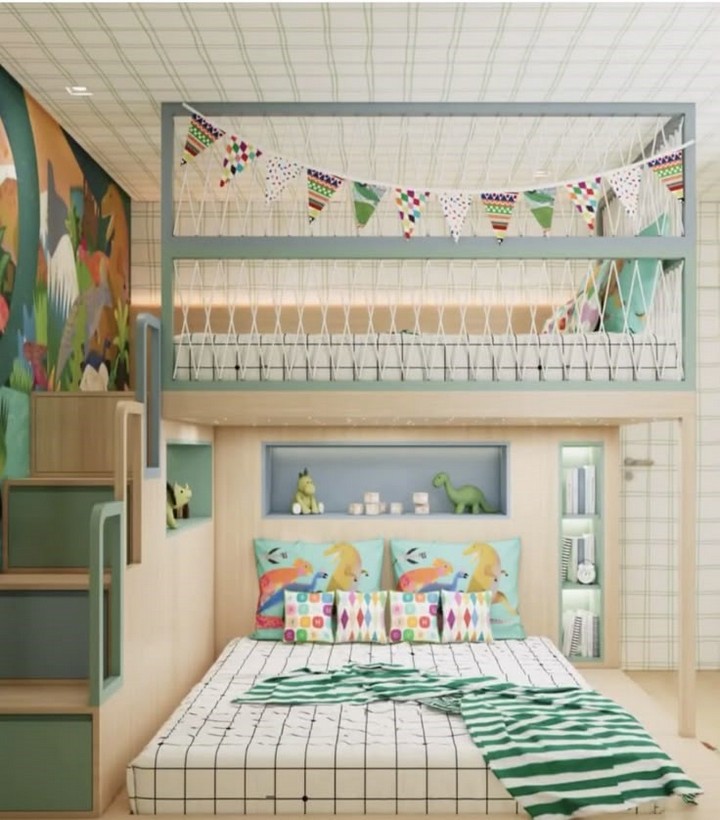
Medieval-themed bunks with tower features, embattlements, and draw-bridge styled entries create magical sleep spaces. These can be designed with gender-neutral aesthetics or customized to individual preferences with appropriate color schemes and decorative elements.
13. Nautical Submarine and Ship Bunks
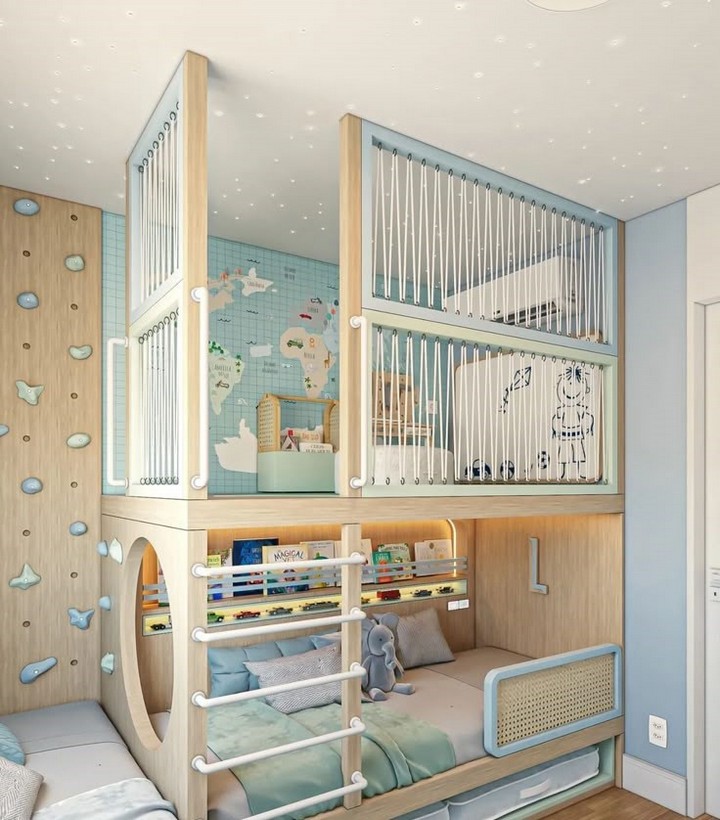
Ocean-loving children will treasure bunk beds designed to resemble submarines or sailing vessels. Incorporate portholes, ship’s wheels, and nautical colors to complete the maritime adventure theme.
14. Space Station and Rocket Bunks
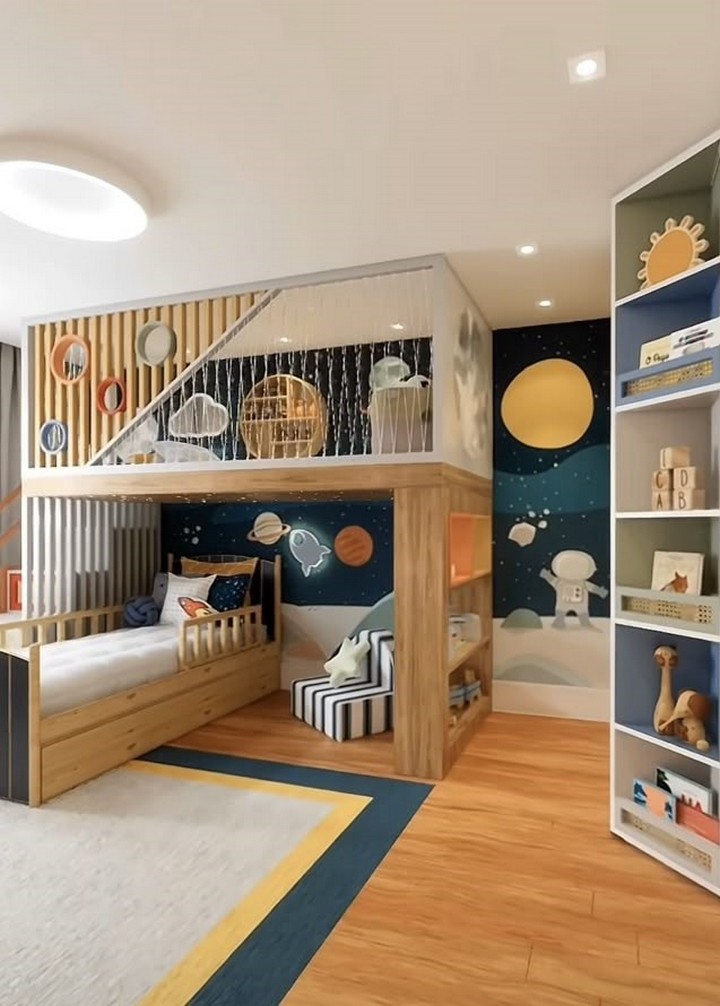
Futuristic space-themed bunks can incorporate LED lighting, metallic finishes, and control panel graphics to create the sensation of sleeping aboard a spacecraft. Consider adding star projectors for immersive nighttime experiences.
15. Wilderness Cabin Bunks
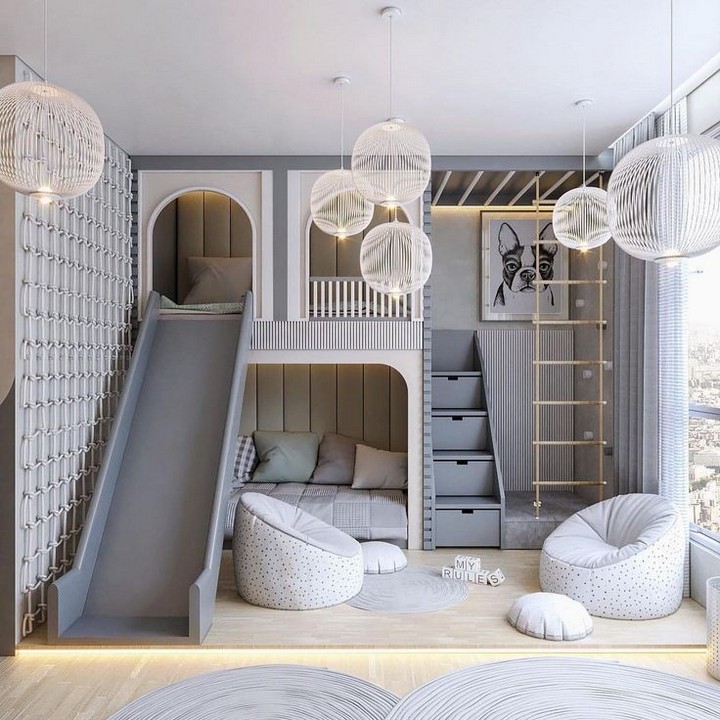
Create a camp-like atmosphere with rustic bunk designs featuring unfinished wood, tent-like canopies, and outdoorsy decorative elements. These designs work beautifully in nature-themed bedrooms and can grow with children through their teen years.
16. Secret Agent Headquarters
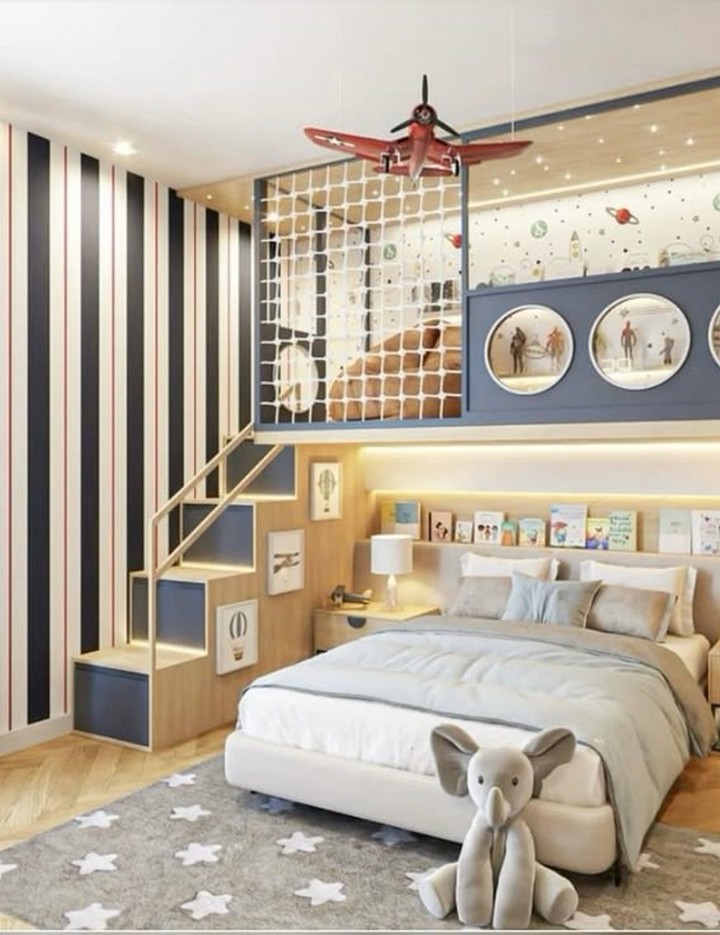
Spy-themed bunks can incorporate secret compartments, coded entry systems, and mission control desks to create immersive play experiences. Consider adding blacklight features or hidden messages for interactive fun.
17. Storybook-Inspired Designs
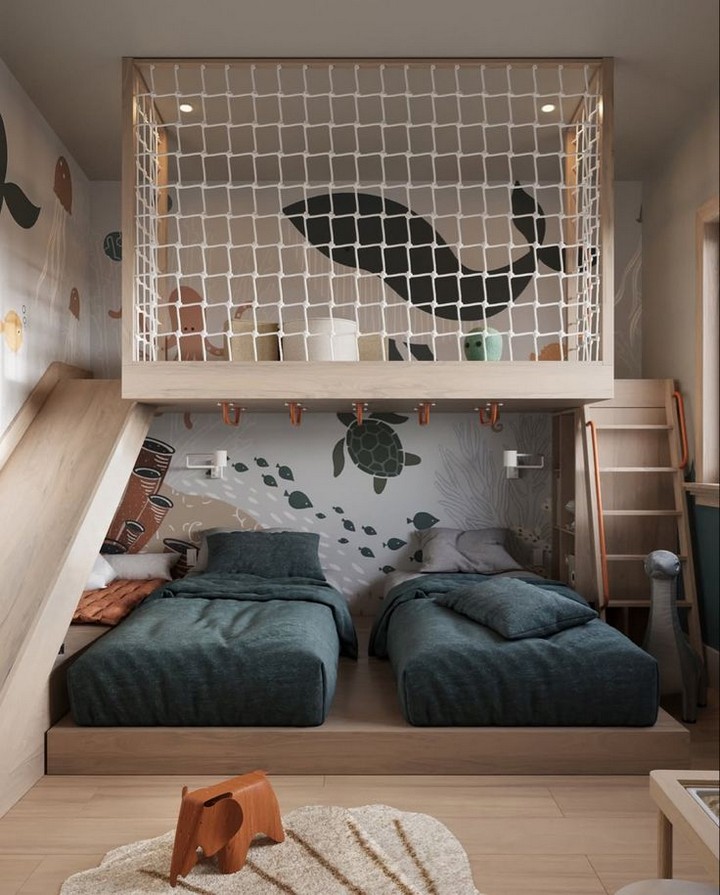
From Narnia wardrobes to Hogwarts dormitories, literature-inspired bunk themes can bring favorite stories to life. These designs are especially powerful for cultivating a love of reading when paired with appropriate book collections and reading nooks.
Storage-Integrated Bunk Solutions
18. Staircase Storage Systems
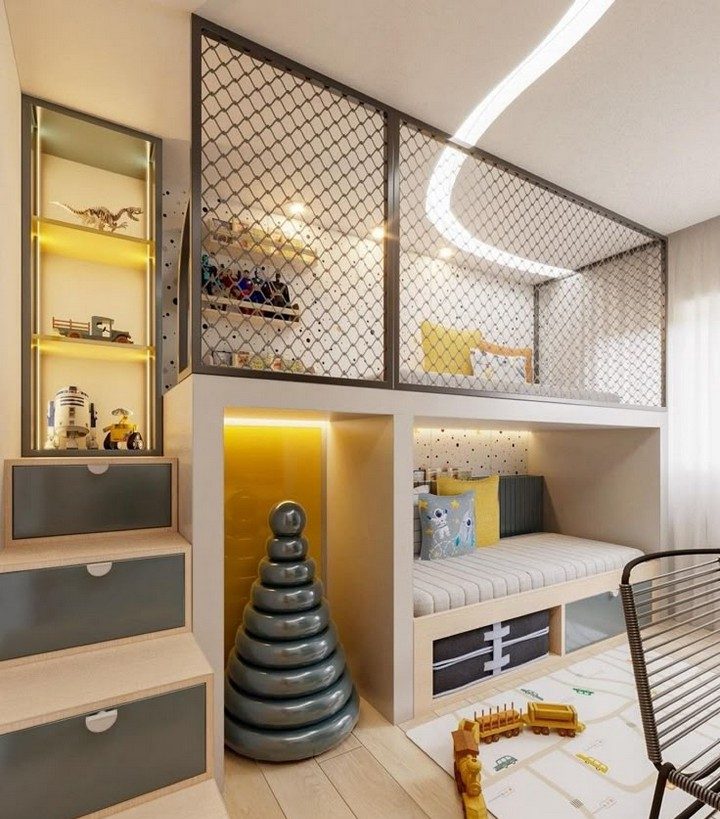
Replace traditional ladders with storage staircases that incorporate drawers or cubbies in each step. This smart solution addresses both access safety and storage needs simultaneously.
19. Headboard and Footboard Shelving
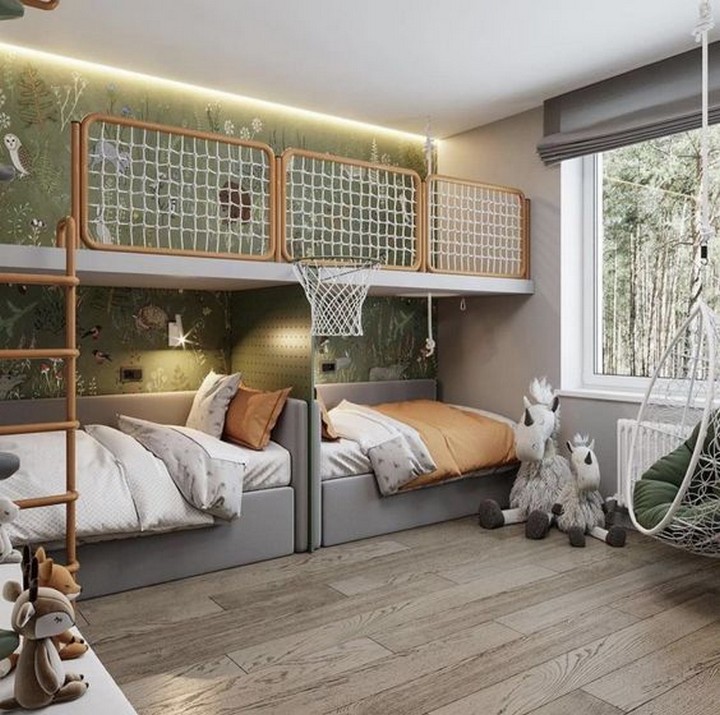
Maximize every inch by choosing bunk designs with integrated shelving in the headboard and footboard areas. These become perfect spots for bedtime books, small toys, or display items.
20. Under-Bed Rolling Storage
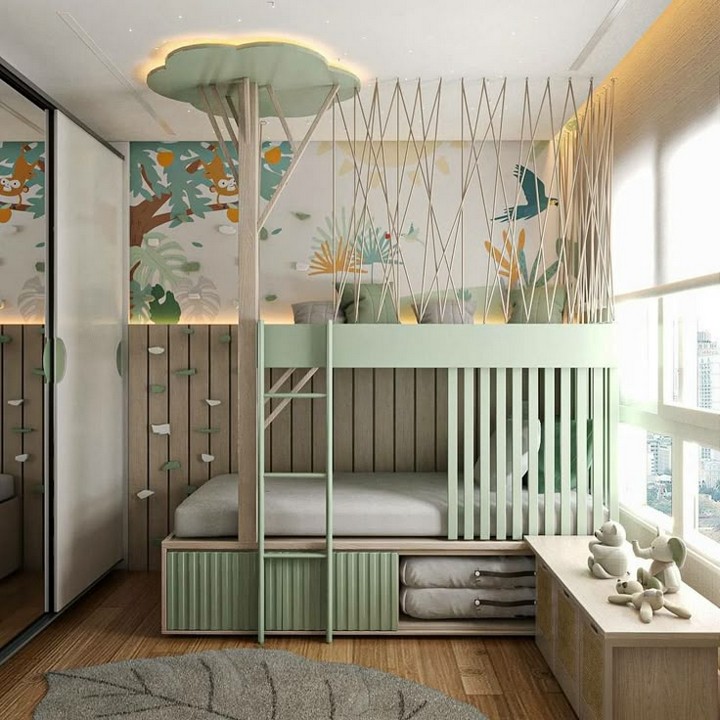
For bottom bunks, consider systems with large rolling drawers or bins that utilize the under-bed space effectively. Look for smooth-gliding mechanisms that children can operate independently.
21. Built-In Wardrobe Combinations
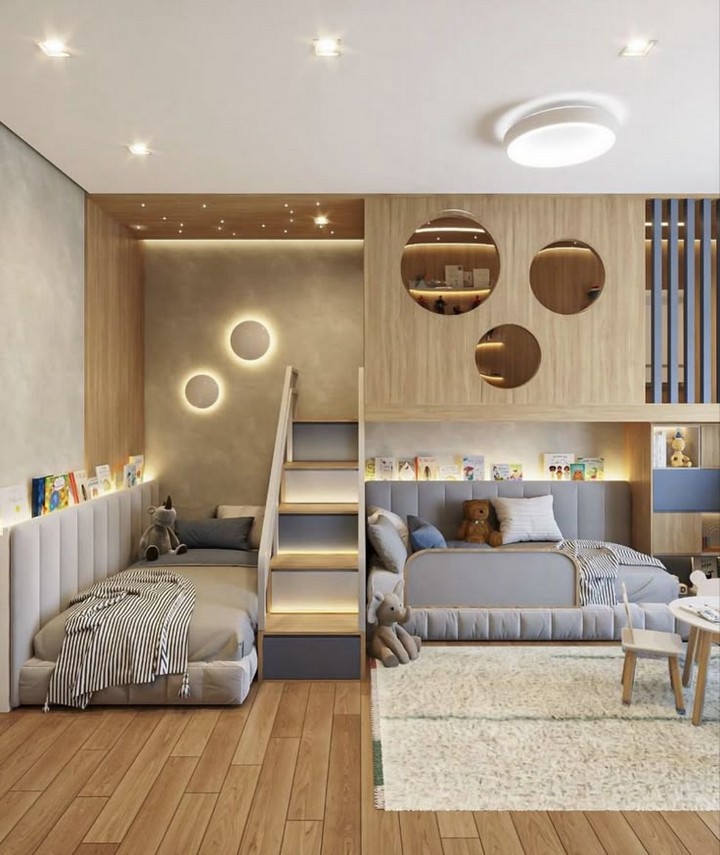
Some comprehensive bunk systems incorporate full wardrobe units, eliminating the need for separate dressers and maximizing room layout efficiency. These work especially well in rectangular rooms where the bunk system can occupy an entire short wall.
22. Perimeter Shelving Integration
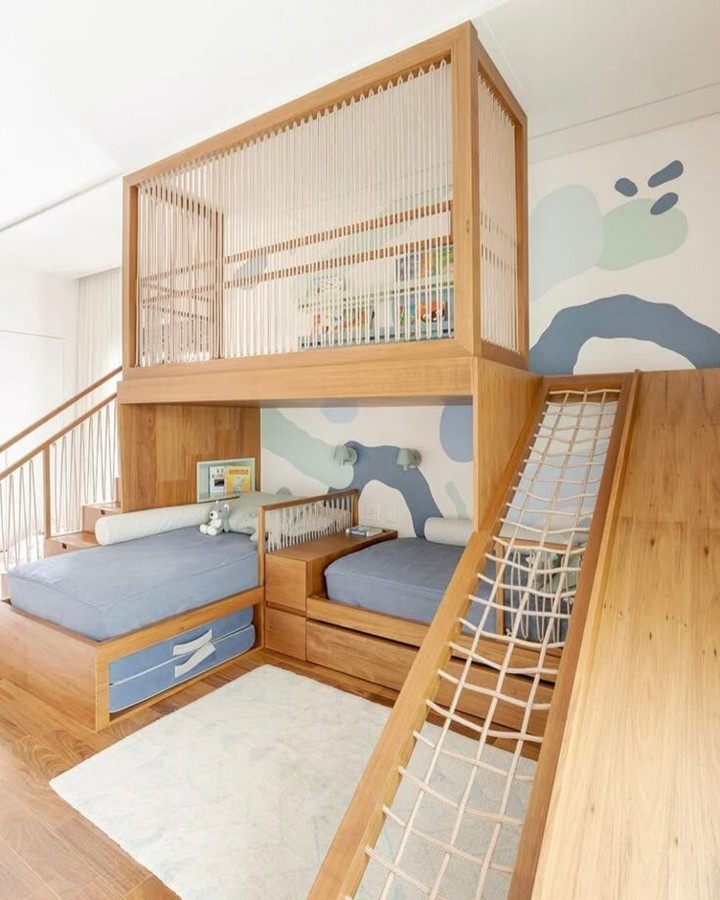
Create a cohesive look by installing shelving that connects with and wraps around the bunk structure. This creates visual continuity while providing display and storage space that complements the beds.
Bunk Beds for Older Children and Teens
23. Industrial-Style Metal Frame Bunks
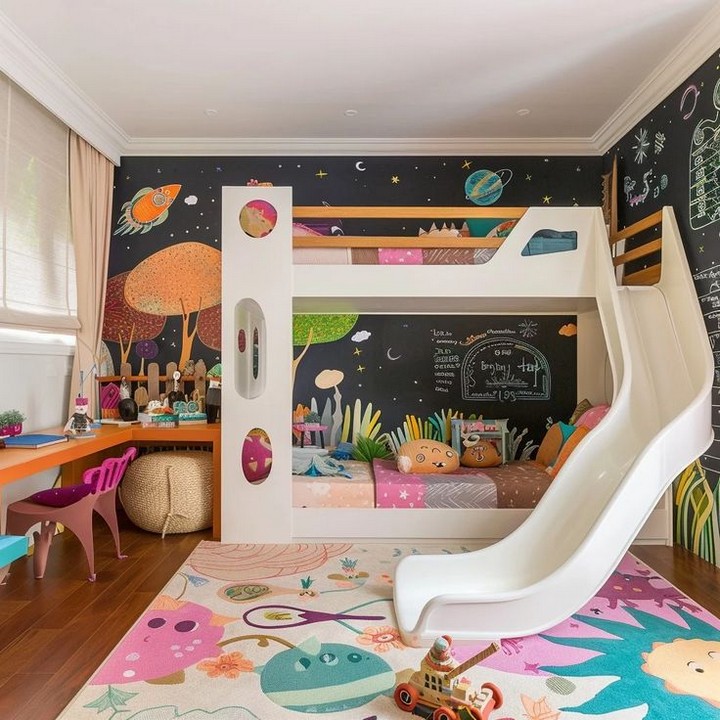
Adolescents often prefer more sophisticated aesthetics. Industrial-style bunks with clean metal lines and minimalist designs offer age-appropriate options that still maximize space.
24. Study Center Lofts
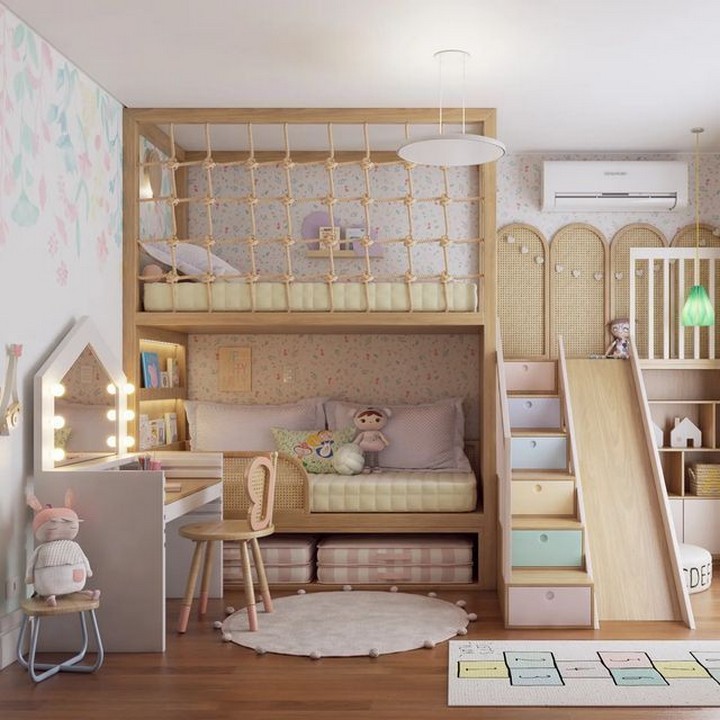
For college-bound teens, comprehensive loft systems with expanded desk spaces, bulletin boards, and task lighting create mini-dorm environments that support academic success while maintaining style.
25. Hangout Space Combinations
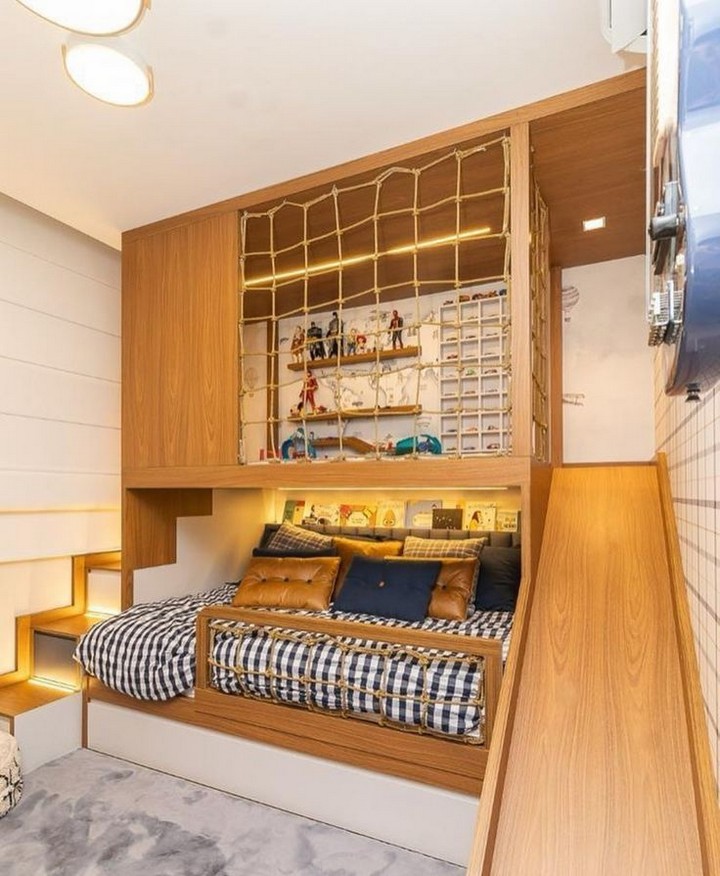
Create teenage-friendly zones by designing lower bunks with convertible seating that transforms the bed into a daytime lounge area with cushion backrests. This dual functionality makes the room suitable for both sleep and socializing.
26. Privacy-Enhanced Designs
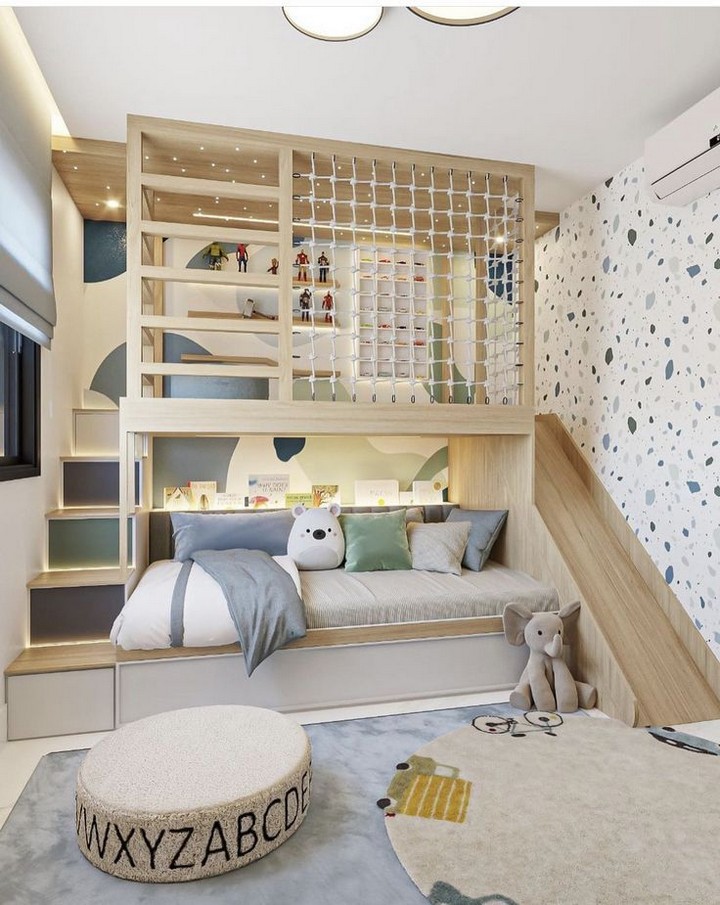
Address teenagers’ growing need for privacy with bunk systems that incorporate curtains, sliding panels, or partial walls between sleeping areas. These features create personal retreats without requiring separate bedrooms.
27. Minimalist Platform Bunks
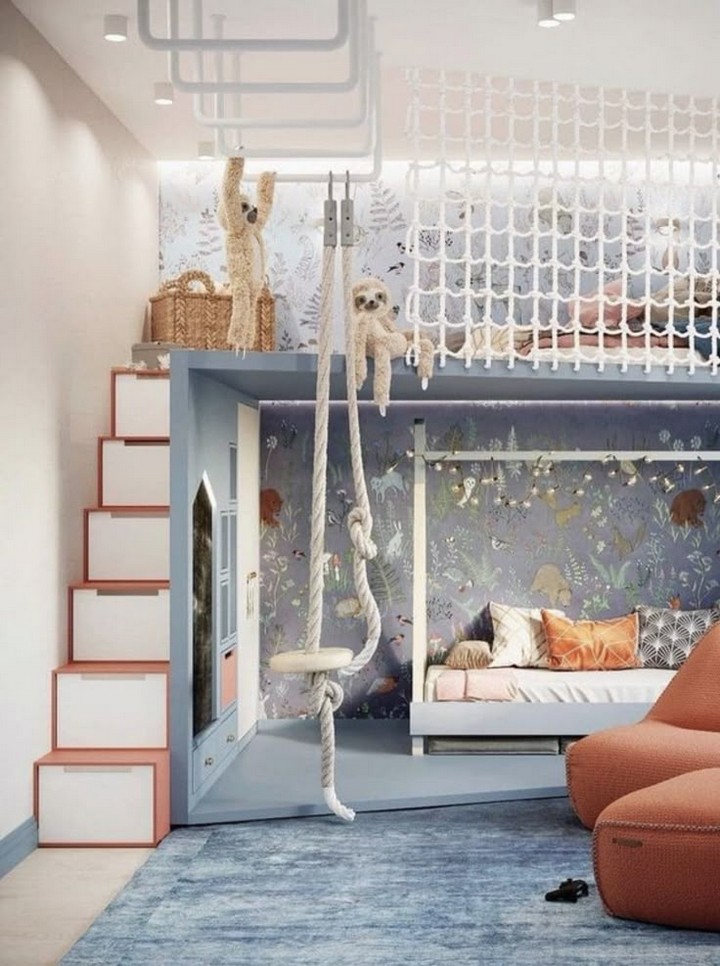
Teens with contemporary taste may prefer streamlined platform-style bunks with floating appearances and integrated lighting. These designs eliminate the “childish” associations of traditional bunks while maintaining space efficiency.
Creative Decor for Bunk Bedrooms
28. Individual Reading Lights
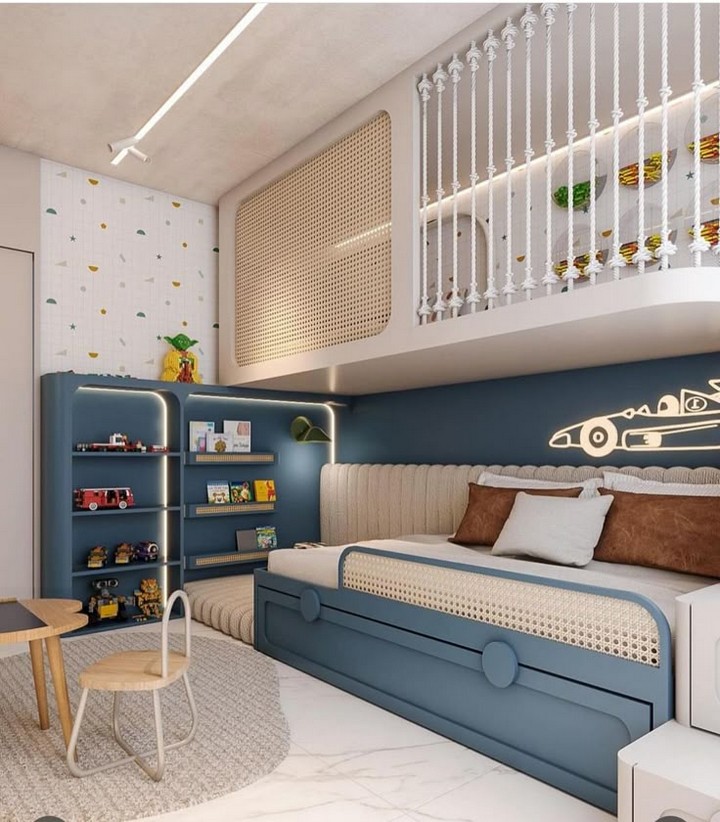
Install adjustable, wall-mounted reading lights for each bunk level, allowing for personalized lighting that won’t disturb siblings. Consider LED options with dimming capabilities for energy efficiency and adaptability.
29. Personalized Privacy Curtains

Add curtain systems that can enclose each bunk, creating private cocoons when desired. Choose washable, flame-retardant fabrics in patterns that complement the overall room design or reflect each child’s personality.
30. Gallery Wall Arrangements
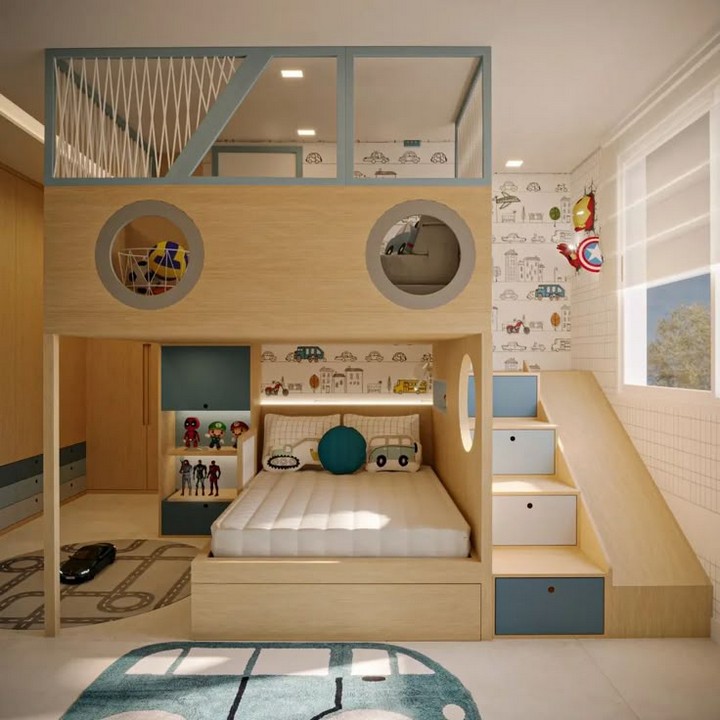
The vertical space alongside bunk beds offers perfect gallery wall opportunities. Create personalized art displays at each child’s eye level, allowing for individual expression within a shared room.
31. Ceiling Treatments for Top Bunks
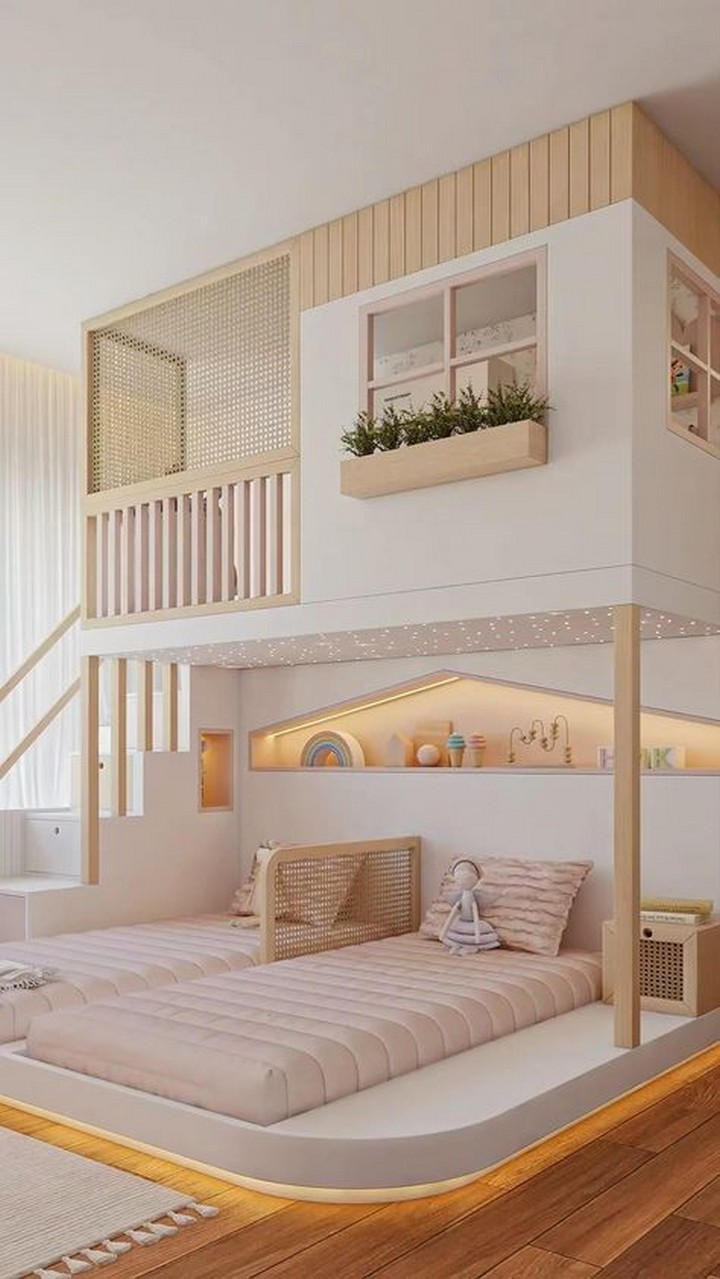
Don’t forget the “ceiling” view for top-bunk sleepers. Consider applying removable wallpaper, glow-in-the-dark star stickers, or even fabric canopies to create magical overhead experiences.
32. Color Zone Differentiation

Use color to define each child’s space within shared bunk rooms. This can be achieved through bedding, wall colors in alcoves, or personalized accessories that create visual boundaries while maintaining a cohesive room design.
Versatile and Convertible Bunk Systems
33. Modular Systems That Grow
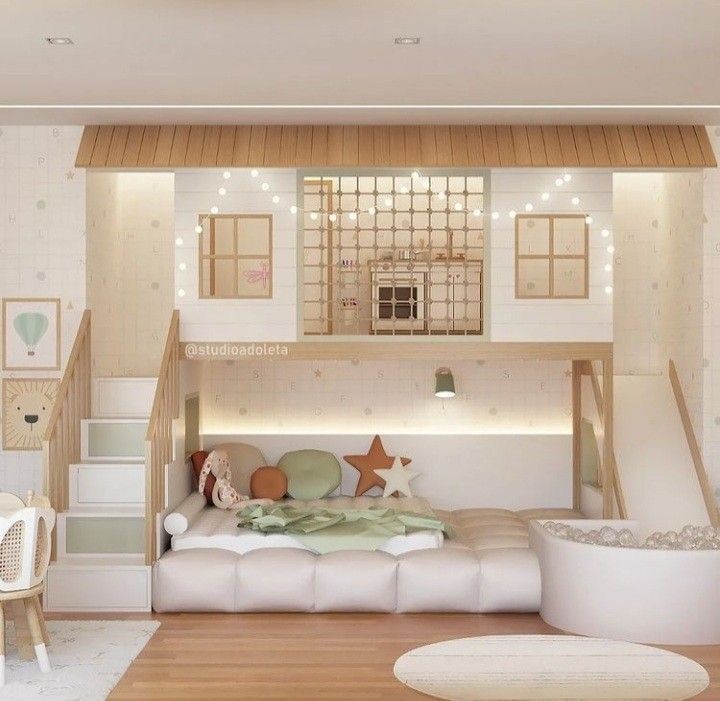
Invest in adaptable bunk systems with components that can be reconfigured as children grow. Some systems convert from standard bunks to loft-and-desk combinations or separate twin beds with minimal additional purchases.
34. Adjustable Height Mechanisms
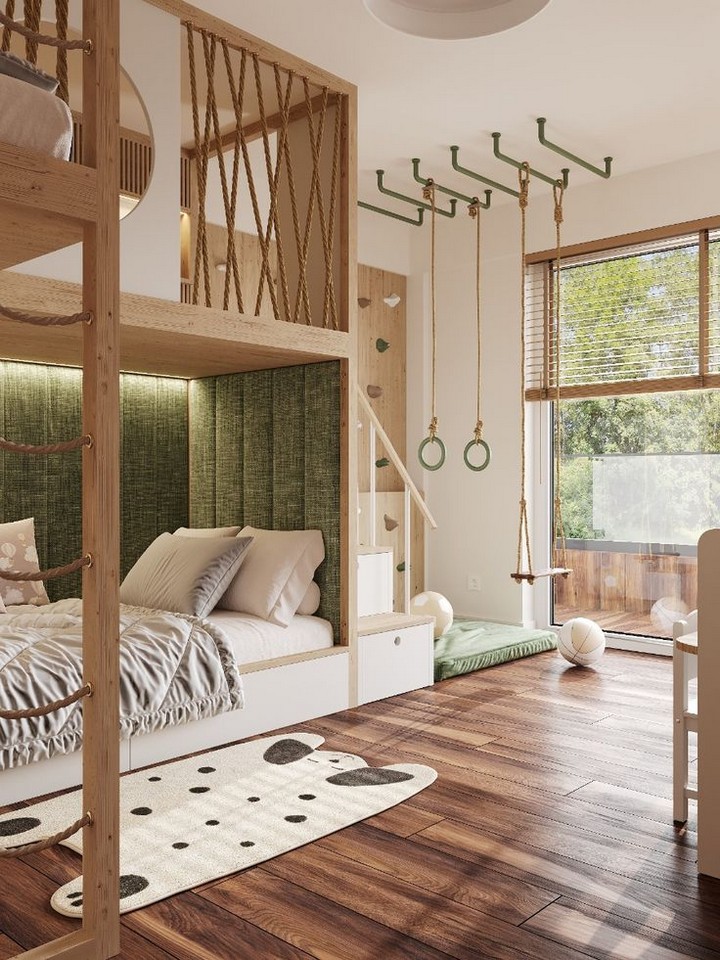
Some innovative bunk designs now offer adjustable height features that allow parents to modify the distance between bunks as needed. This can accommodate changing mattress thicknesses or growing children.
35. Indoor/Outdoor Convertible Spaces
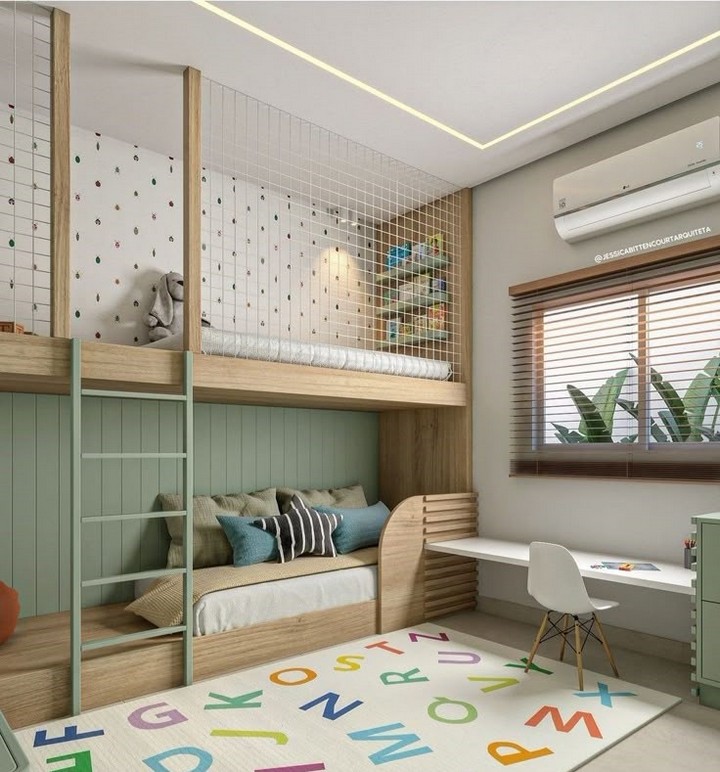
For homes with appropriate climates and architecture, consider bunk systems near large windows or patio doors that create indoor/outdoor connections. Add weather-resistant fabrics and easily washable elements for practical enjoyment.
36. Guest Room Flexibility
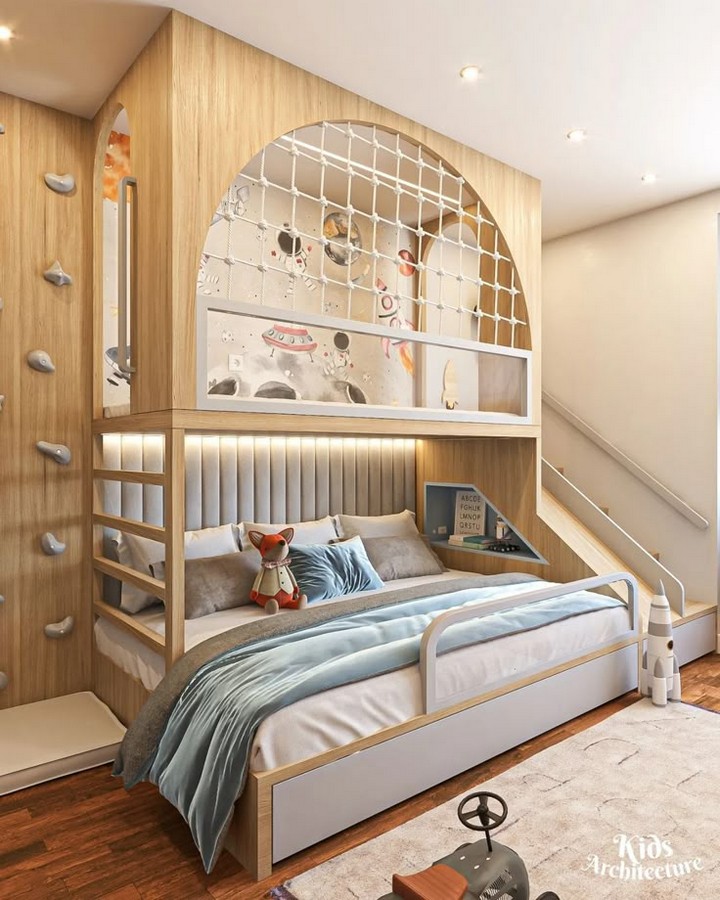
Design bunk rooms that can transition easily to guest accommodations when children are away. Choose sophisticated bedding options that can be swapped in for a more adult-appropriate aesthetic when needed.
37. Play-to-Sleep Transformers
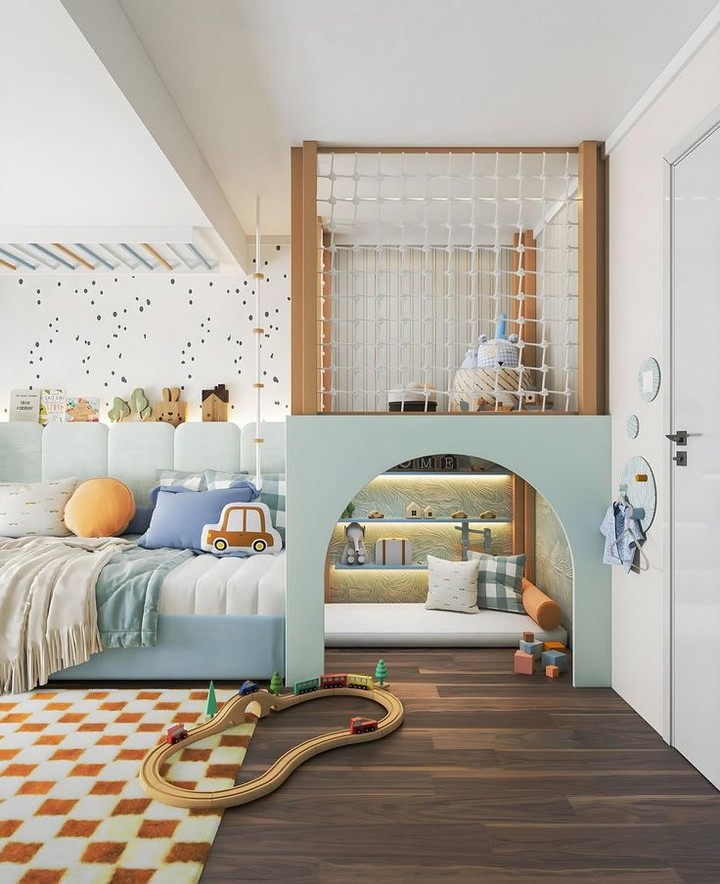
Some creative bunk systems incorporate play elements that transform for sleep. From desk surfaces that flip to reveal beds to play structures that convert to sleeping platforms, these multi-functional designs maximize both fun and function.
Specialized Bunk Room Concepts
38. Built-In Reading Nooks
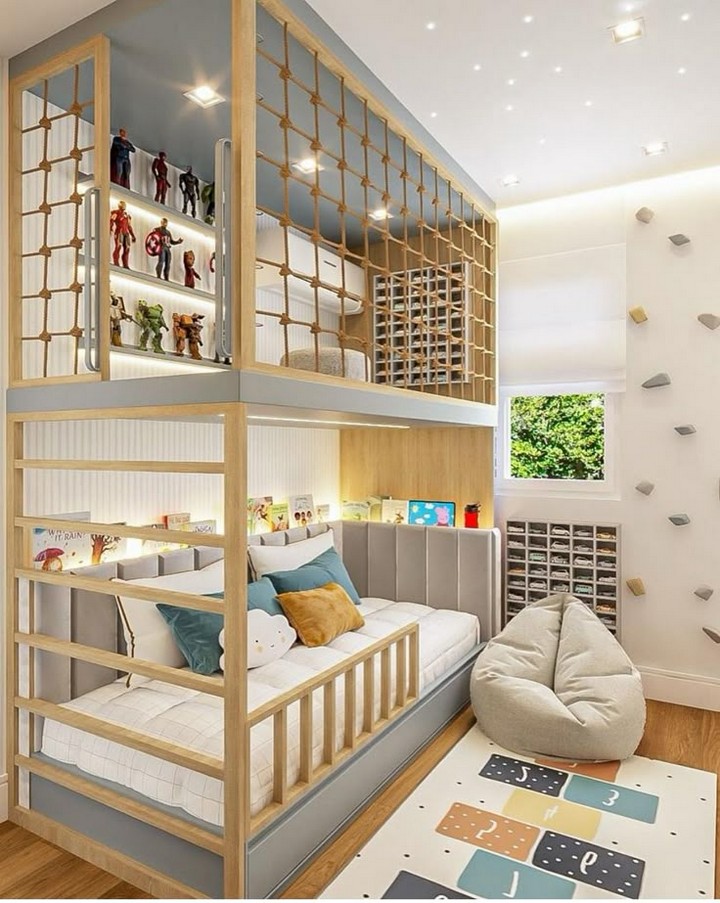
Incorporate cozy reading alcoves adjacent to bunk structures. These can feature cushioned seating, strategic lighting, and book storage to create dedicated reading retreats within the bedroom landscape.
39. Gaming Station Integration
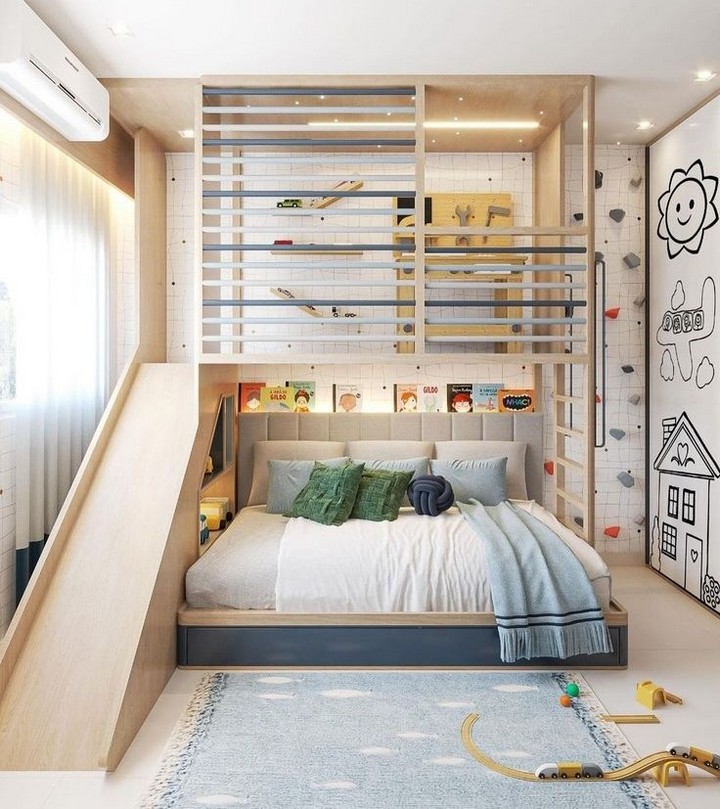
For tech-savvy children, bunk systems with dedicated gaming zones keep electronics organized and contained. Look for designs with cable management, controller storage, and appropriate screen positioning.
40. Homework Pods for Multiple Children
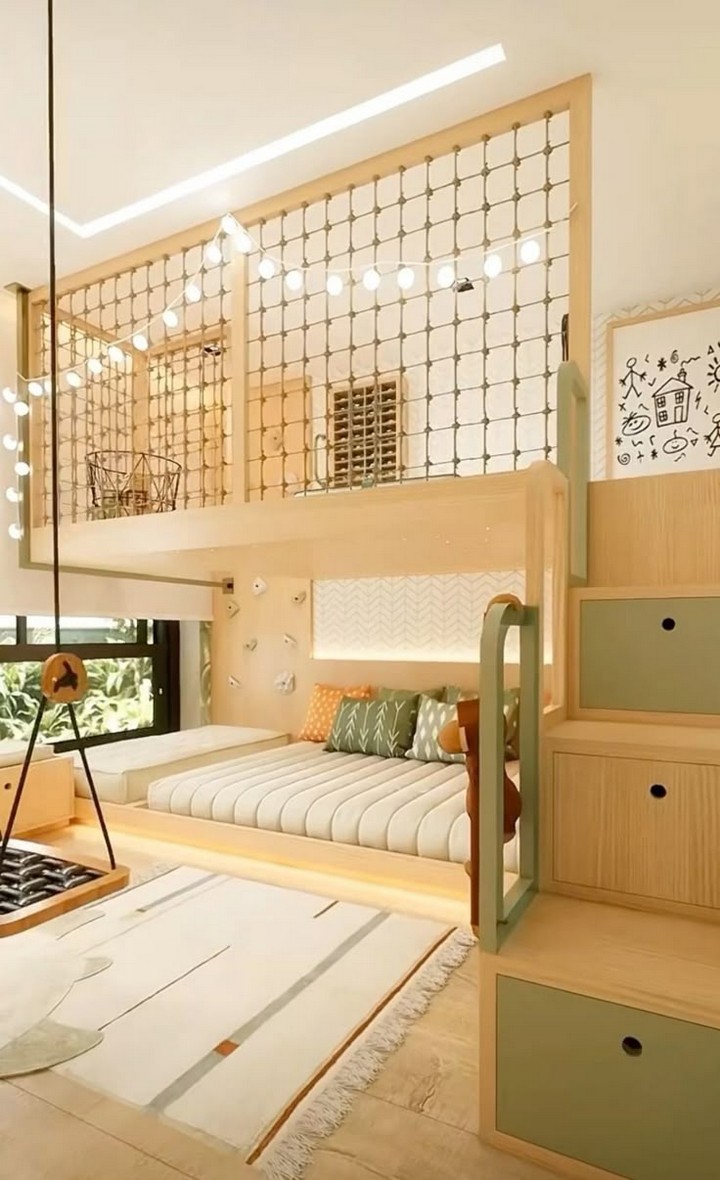
In rooms shared by school-aged siblings, consider bunk arrangements with dual desk spaces, each equipped with appropriate lighting and storage for school supplies. Position these to minimize visual distraction between workstations.
41. Creative Arts Stations
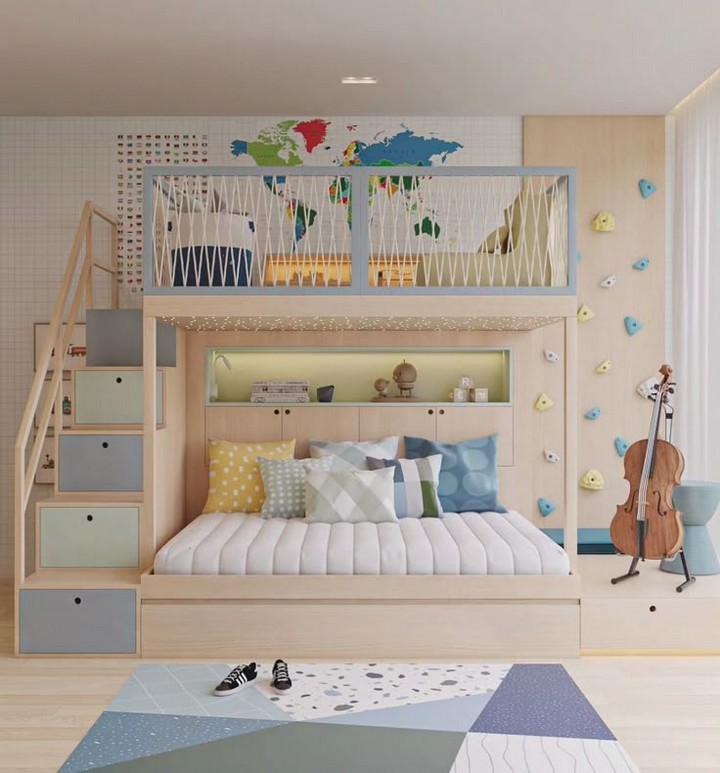
Nurture artistic talents with bunk configurations that incorporate art tables, supply storage, and display areas for finished works. Look for surfaces that resist stains and are easily cleaned after creative sessions.
42. Music Corner Combinations
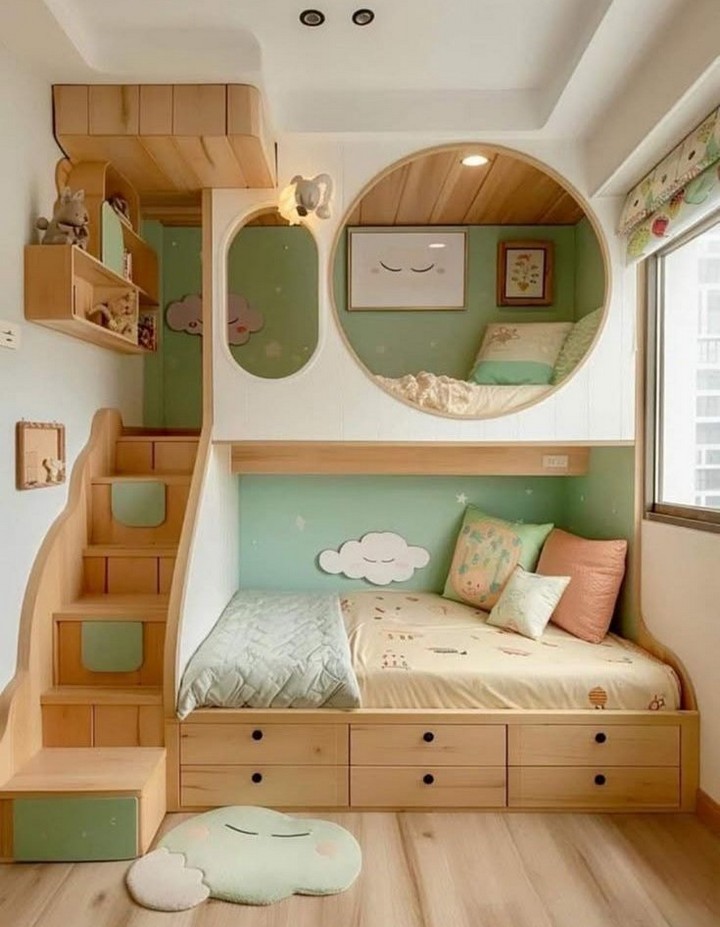
For musical children, some specialized bunk designs incorporate instrument storage, small practice spaces, or even sound-dampening features that allow for practice without disturbing others.
43. Nature-Connected Designs
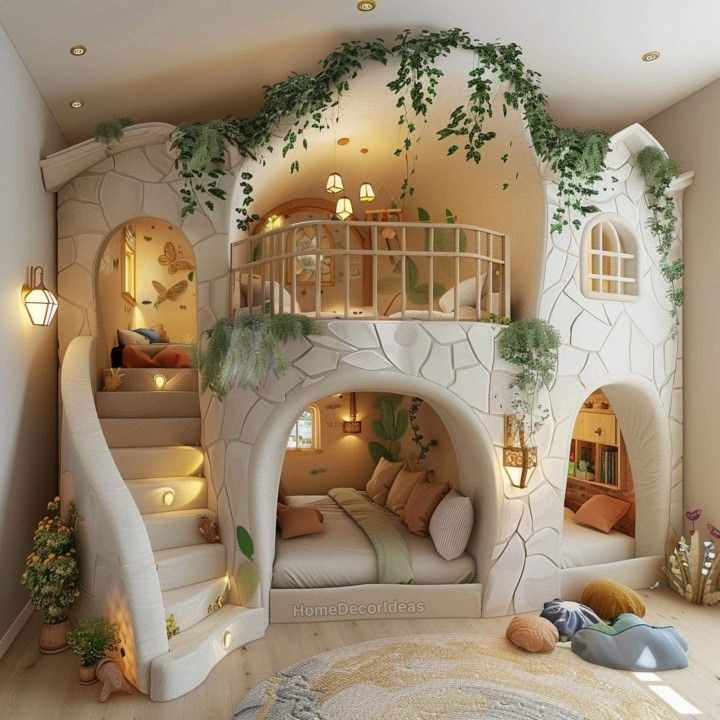
Position bunk beds near windows with natural views when possible. Add indoor plants, nature-inspired textiles, and materials that connect the sleep space to the outdoor environment for enhanced well-being.
44. Accessible Adaptive Designs
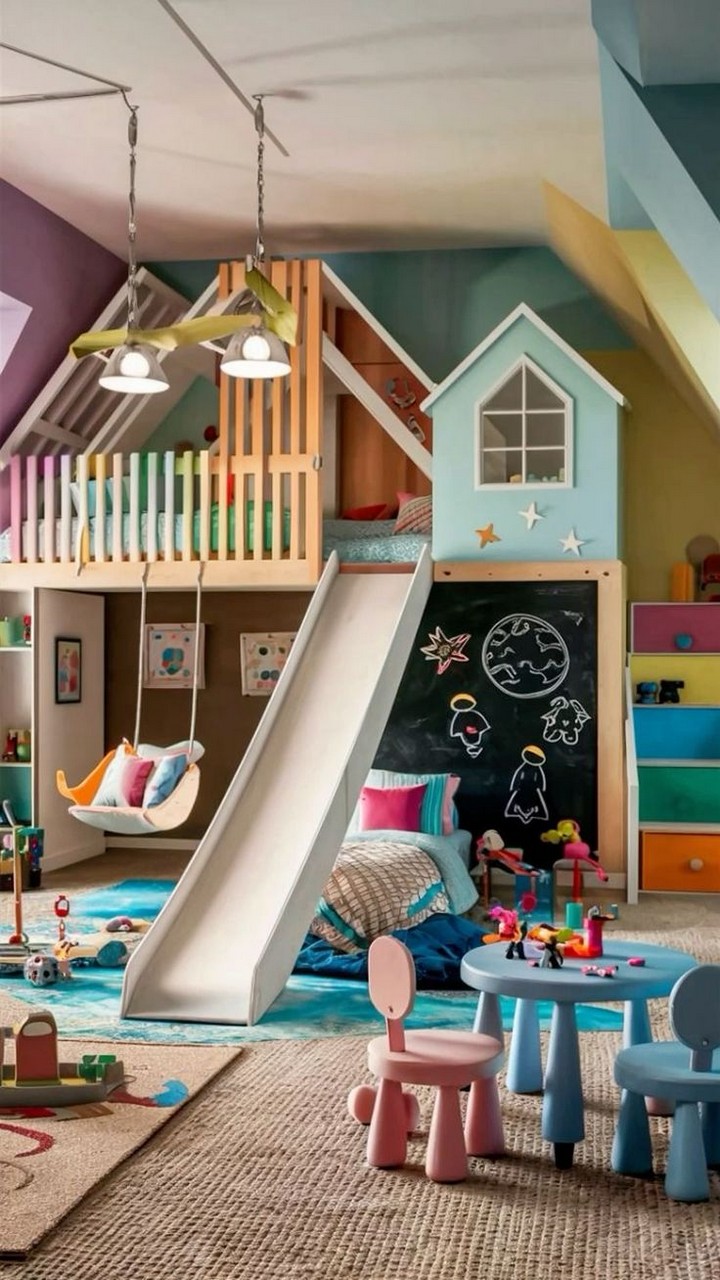
Families with children who have mobility considerations can explore adaptive bunk designs with features like transfer bars, wider access points, or specialized safety systems that ensure all children can enjoy elevated sleep spaces safely.
Practical Tips for Implementing Bunk Bedroom Designs
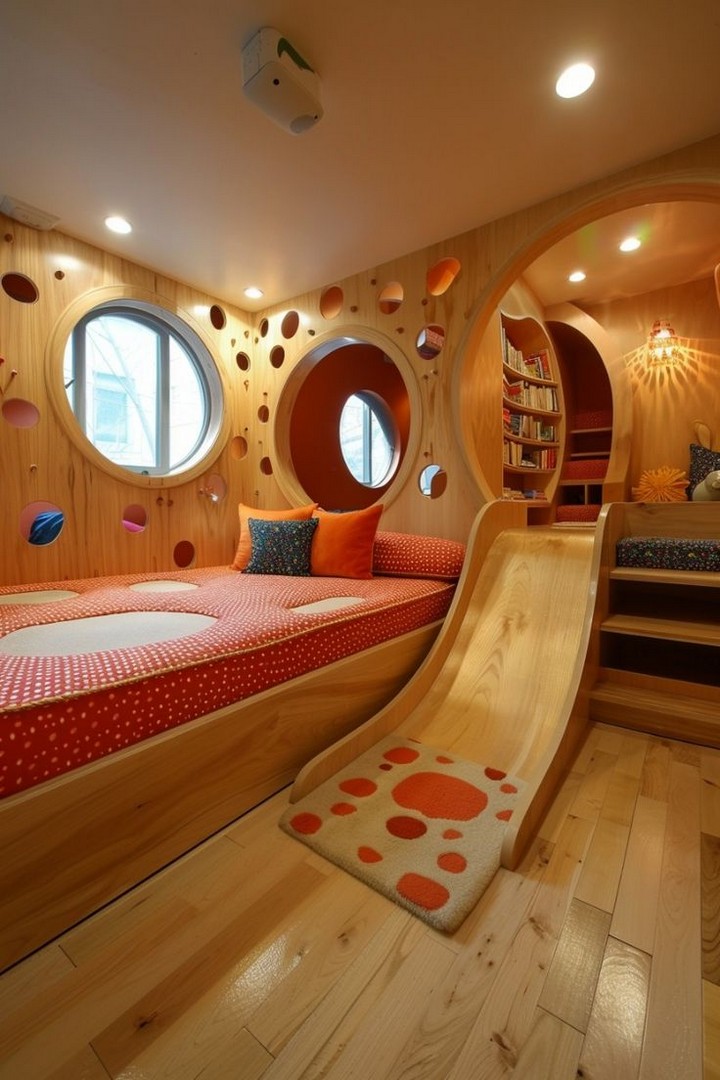
When planning your kids’ bunk bedroom, consider these practical implementation tips:
- Measure Carefully: Always measure ceiling height, door clearances, and window positions before purchasing bunk systems.
- Consider Assembly Requirements: Some systems require professional installation, while others are designed for DIY assembly.
- Plan for Mattress Thickness: Most bunk beds have maximum recommended mattress thicknesses for safety reasons, typically 6-8 inches for top bunks.
- Establish Clear Rules: Create and communicate clear guidelines for safe bunk bed use, appropriate for children’s ages.
- Create Maintenance Schedules: Changing linens on top bunks can be challenging; establish systems that make this task manageable.
- Involve Children in Planning: When appropriate, involve your children in the design process to increase their investment in caring for the space.
- Consider Future Needs: Choose systems that can adapt to your family’s changing requirements over multiple years.
Creating Dream Bunk Bedrooms That Last
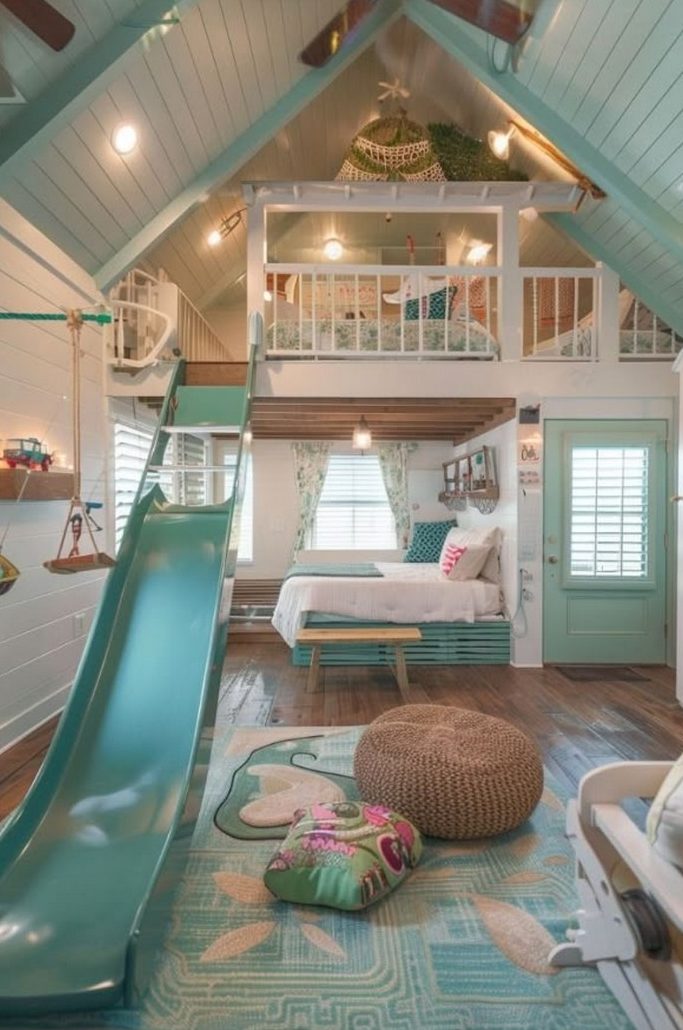
The perfect kids bunk bedroom balances practical considerations with imaginative design elements. By thoughtfully addressing safety, storage, personalization, and adaptability, you can create sleep spaces that not only serve your family’s current needs but evolve gracefully as children grow.
Remember that the most successful bunk bedroom designs consider both the practical realities of daily life and the magical potential of childhood imagination. Whether you’re working with a compact urban apartment or a spacious family home, the right bunk configuration can transform ordinary bedrooms into extraordinary environments where children thrive.
With careful planning and creative vision, your investment in quality bunk bedroom design will pay dividends in space efficiency, sibling harmony, and childhood joy for years to come.
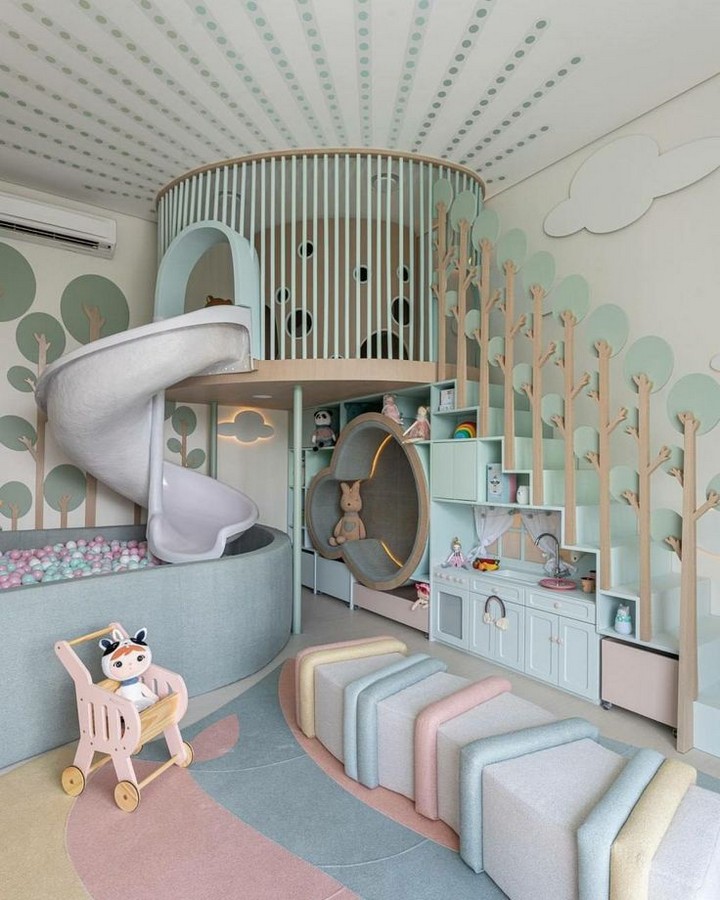
Have you implemented any of these bunk bed ideas in your children’s bedrooms? We’d love to see your creative solutions! Share your photos in the comments below or tag us on social media with #BunkBedroomInspo.
Planning a bunk bedroom project and have questions? Drop them in the comments, and our design experts will provide personalized suggestions to help you create the perfect sleep space for your children.

